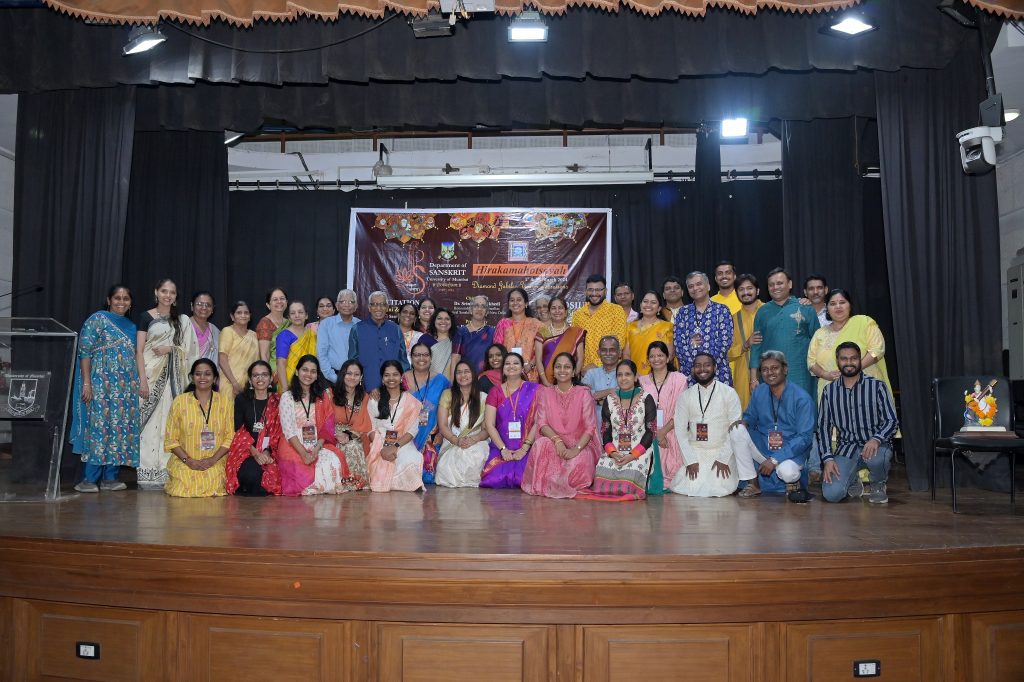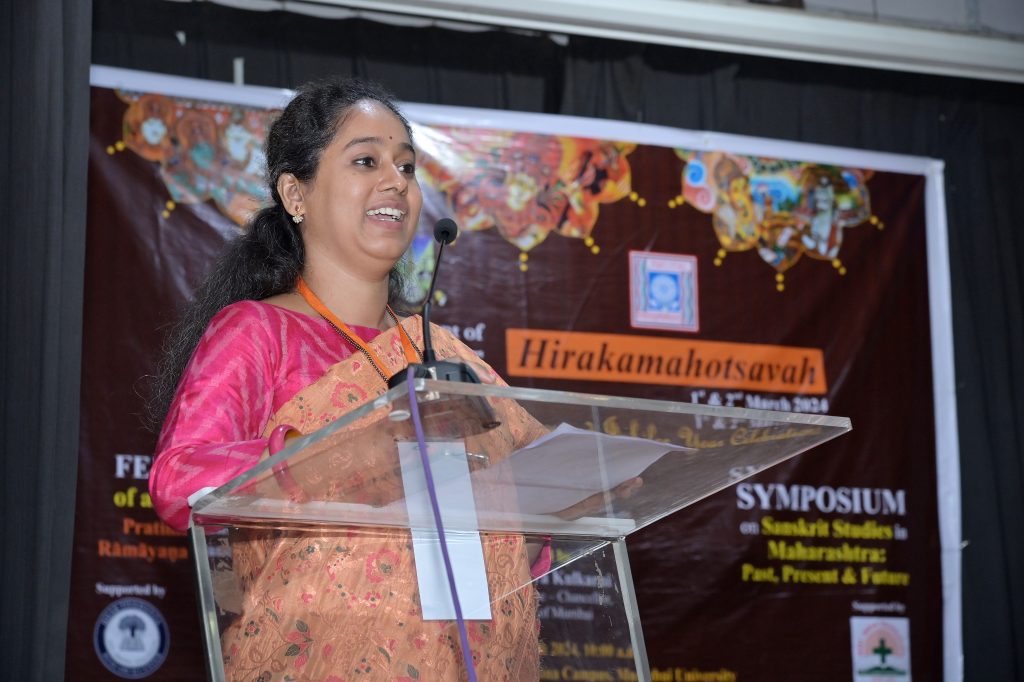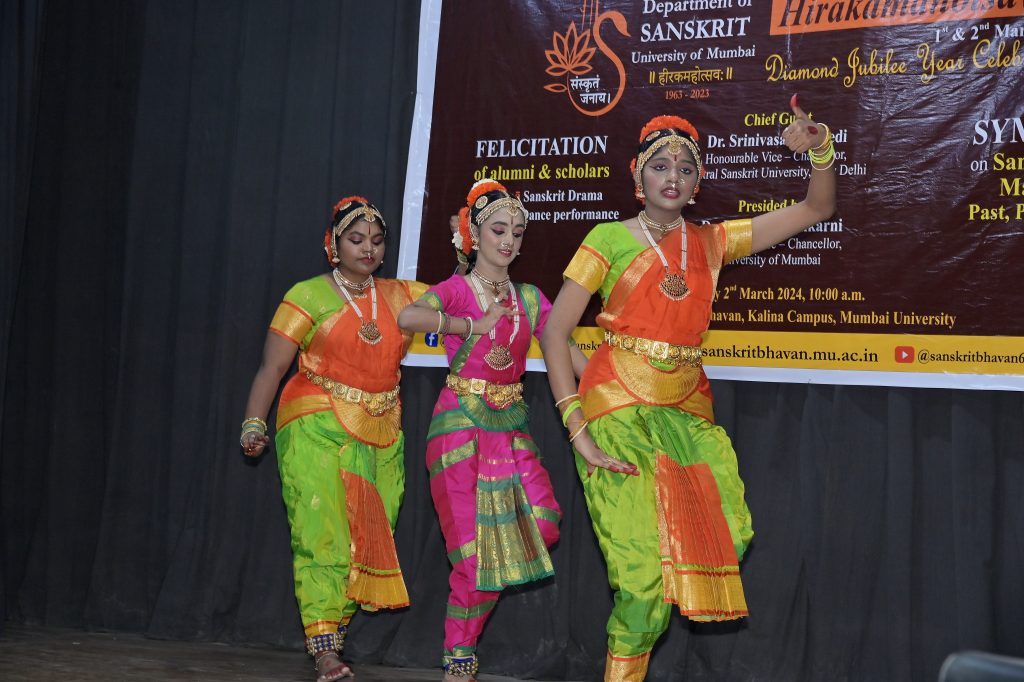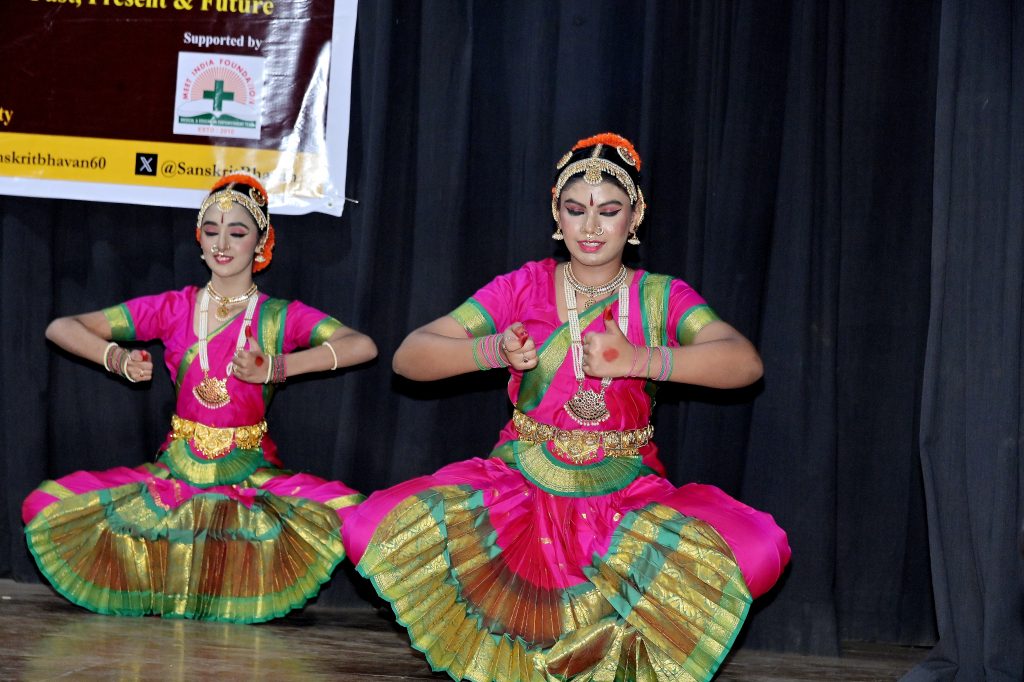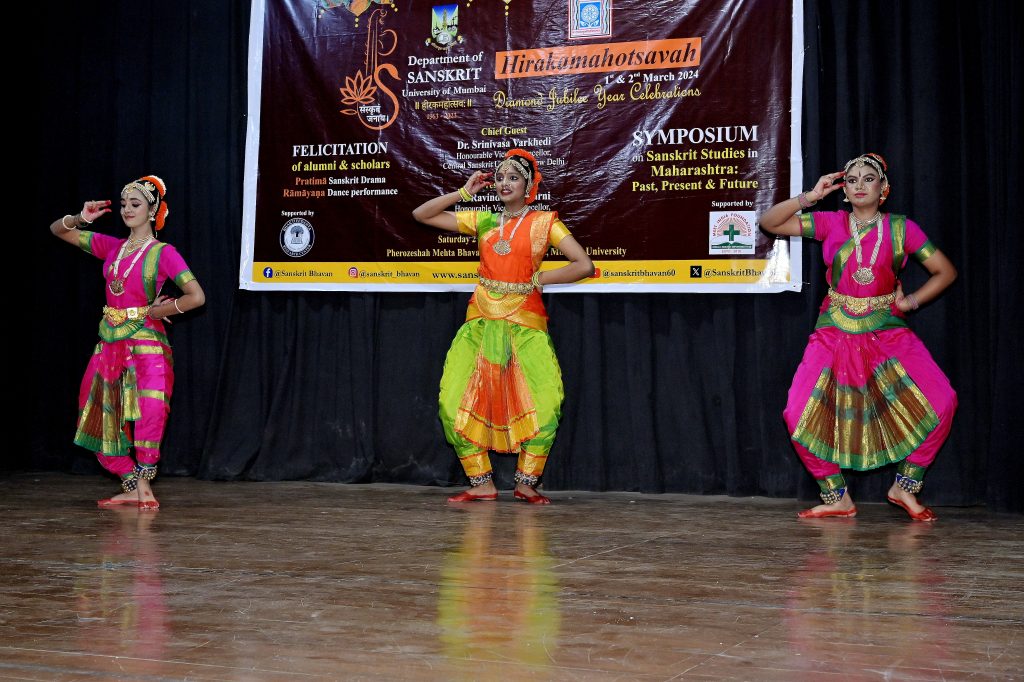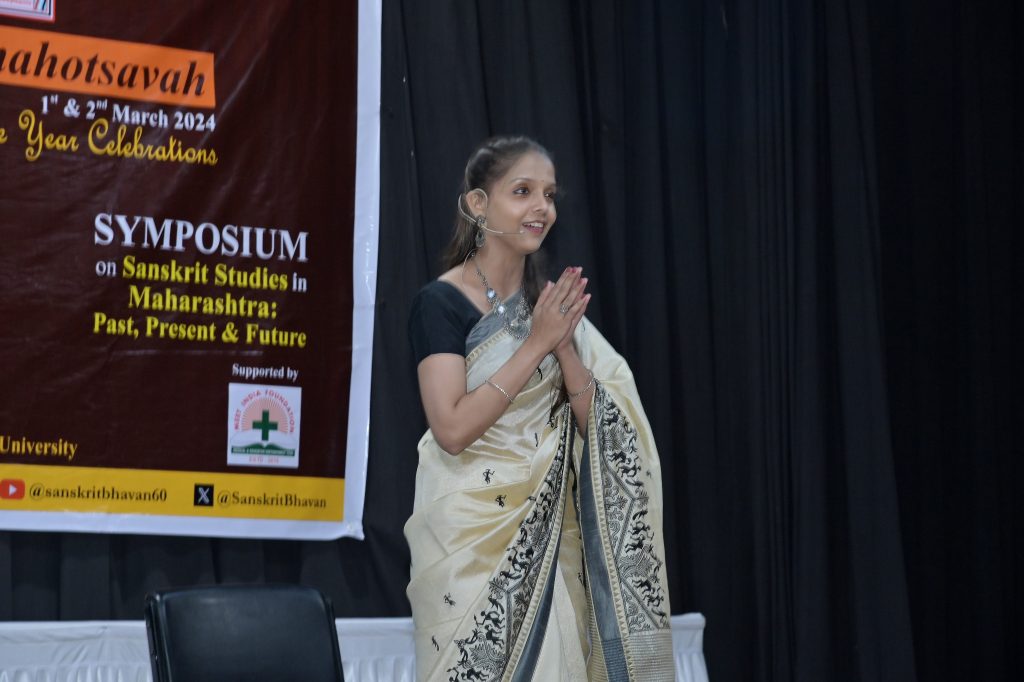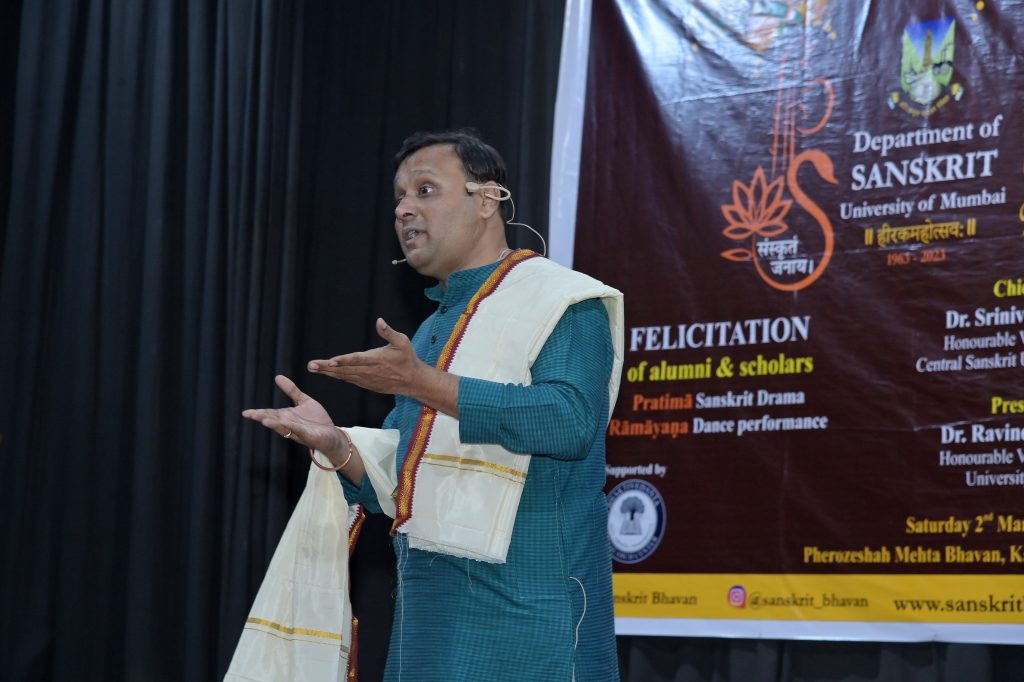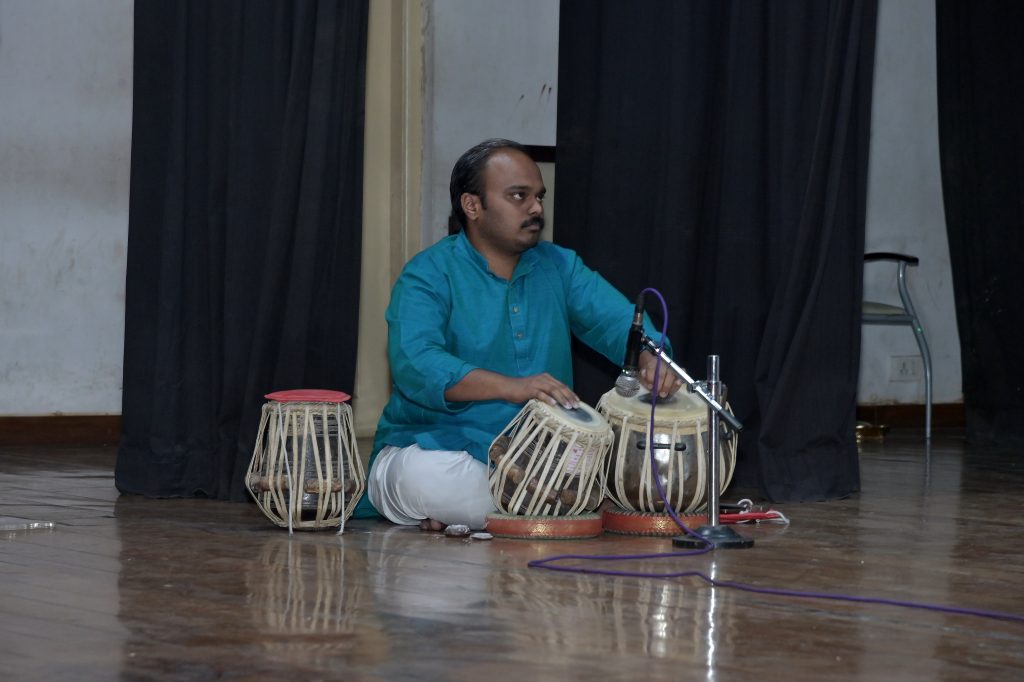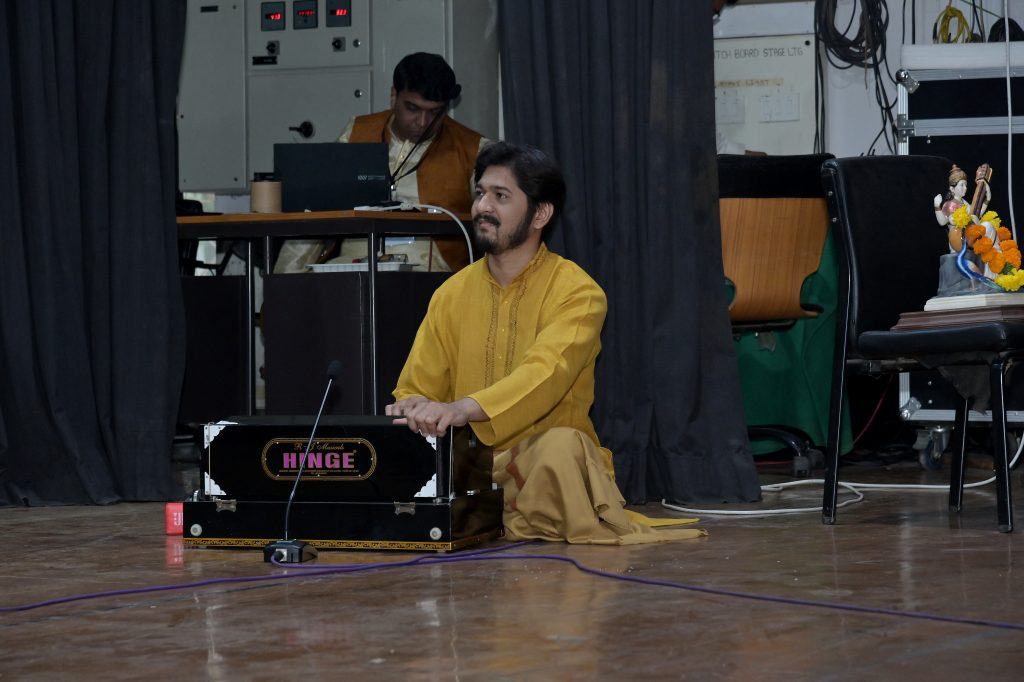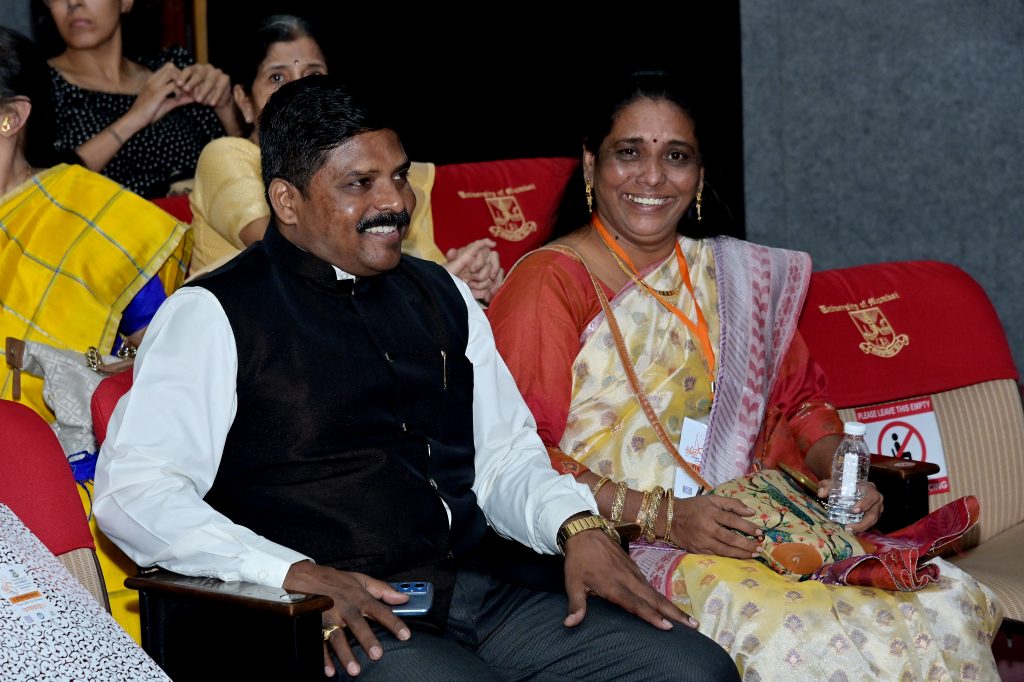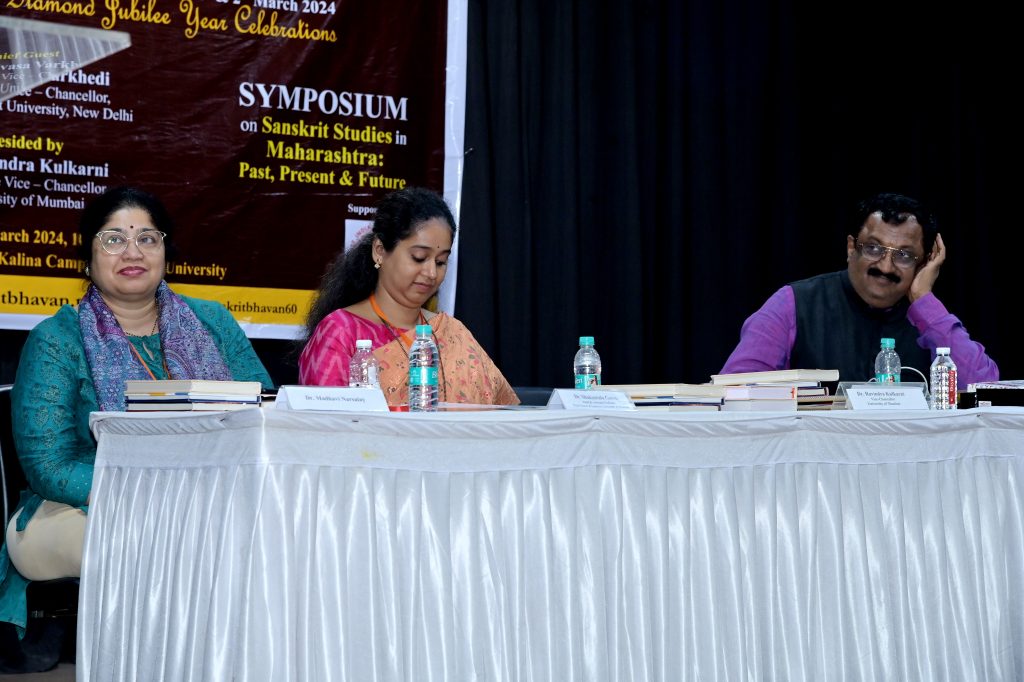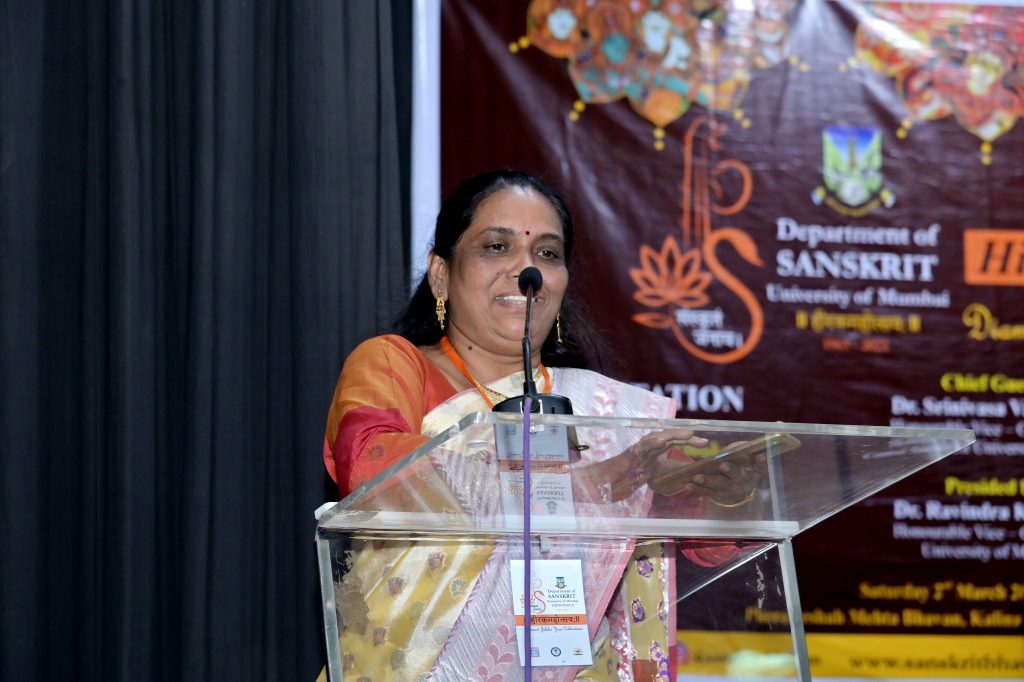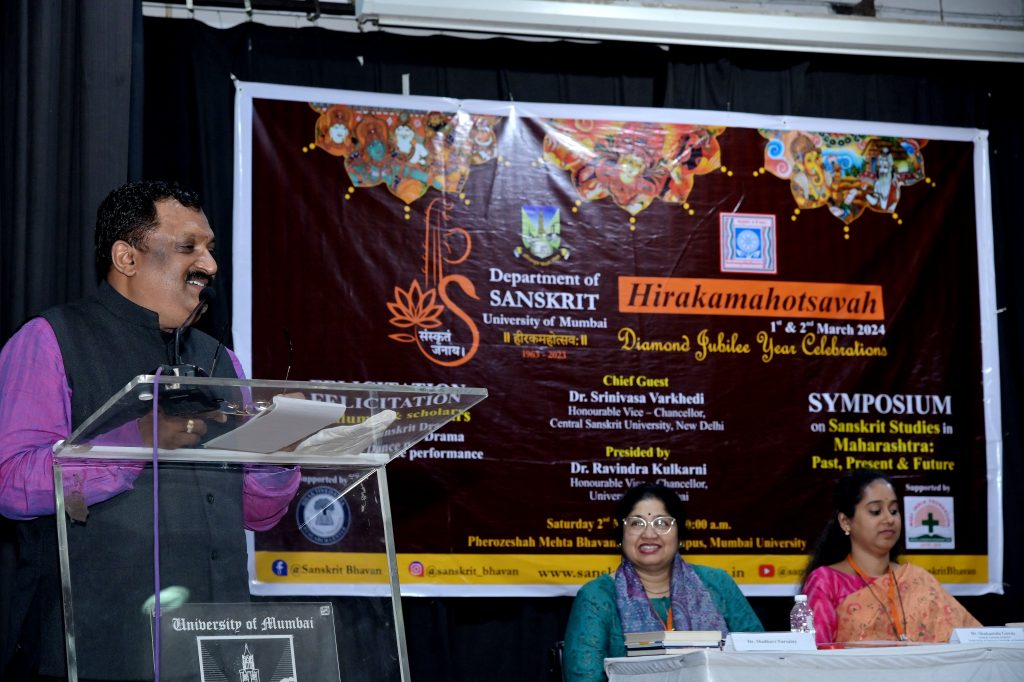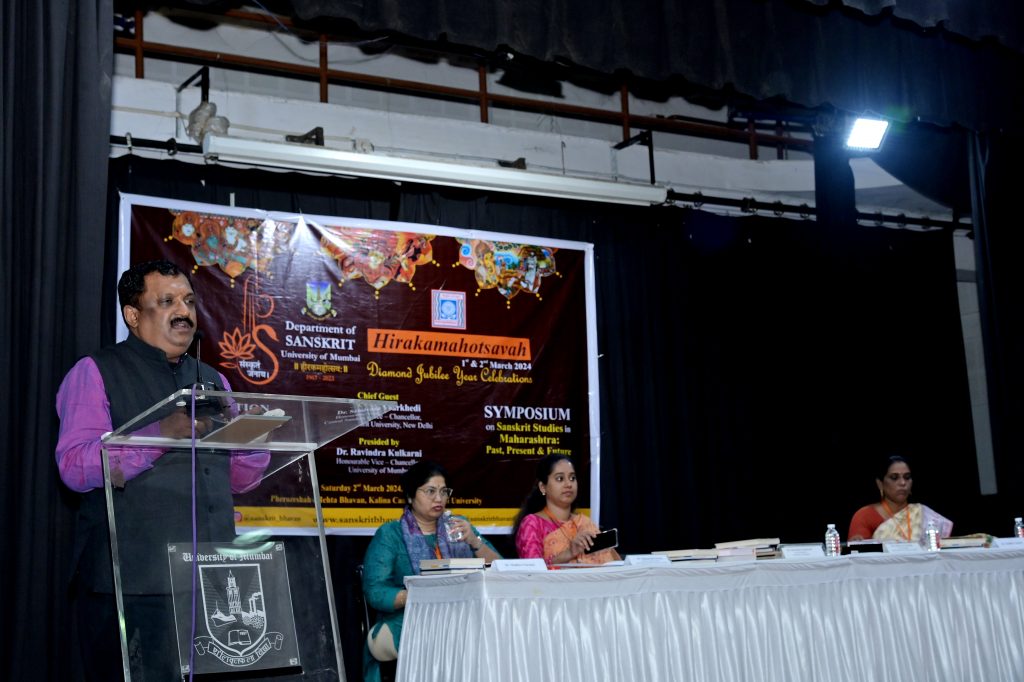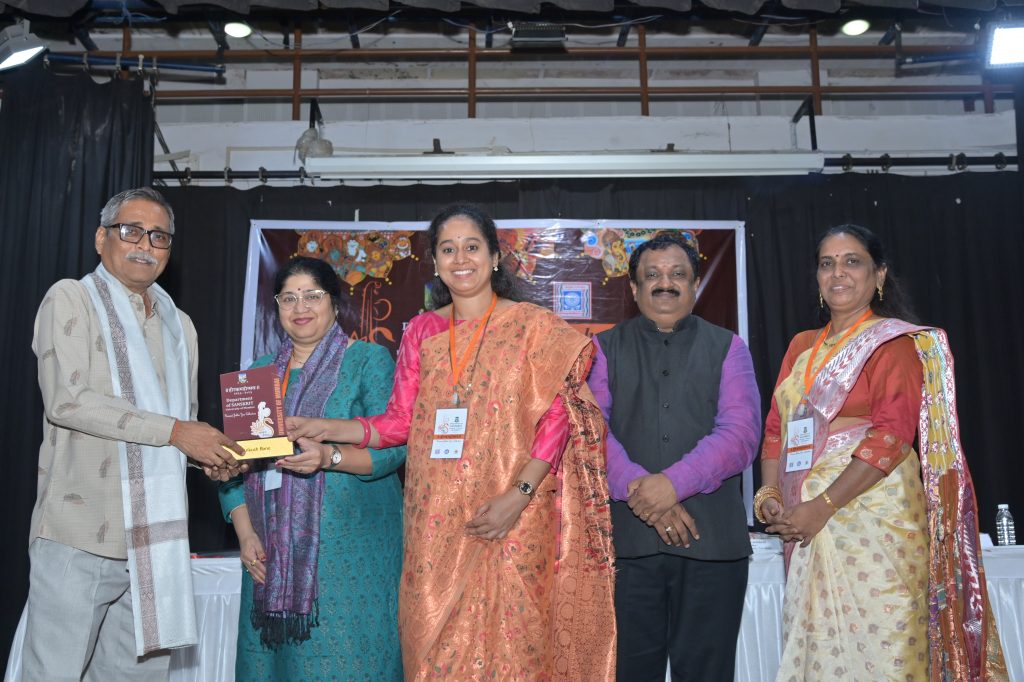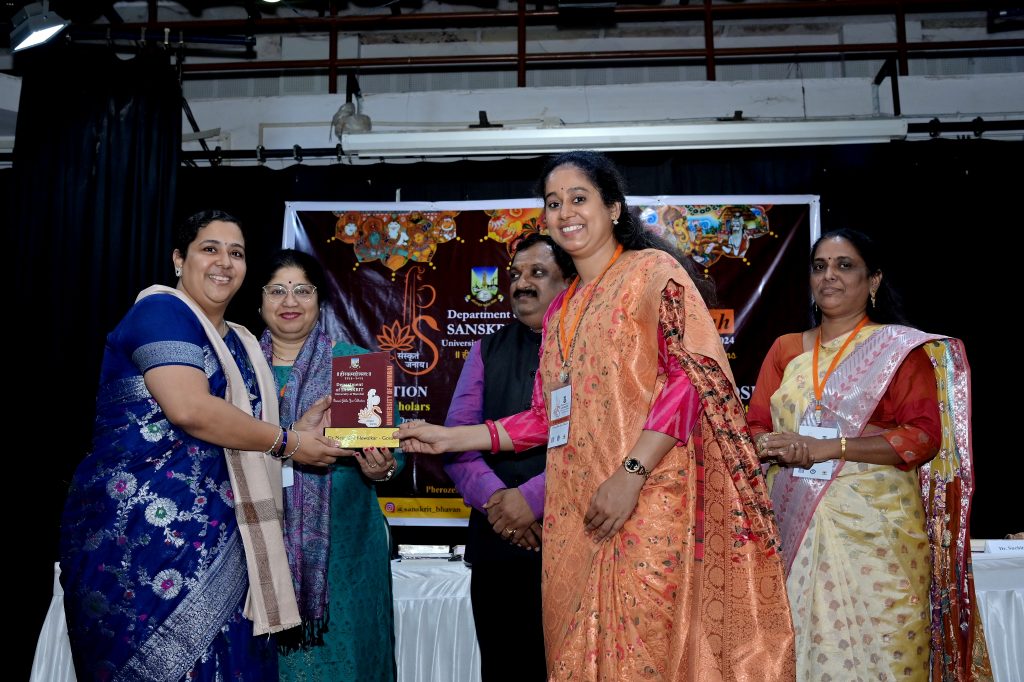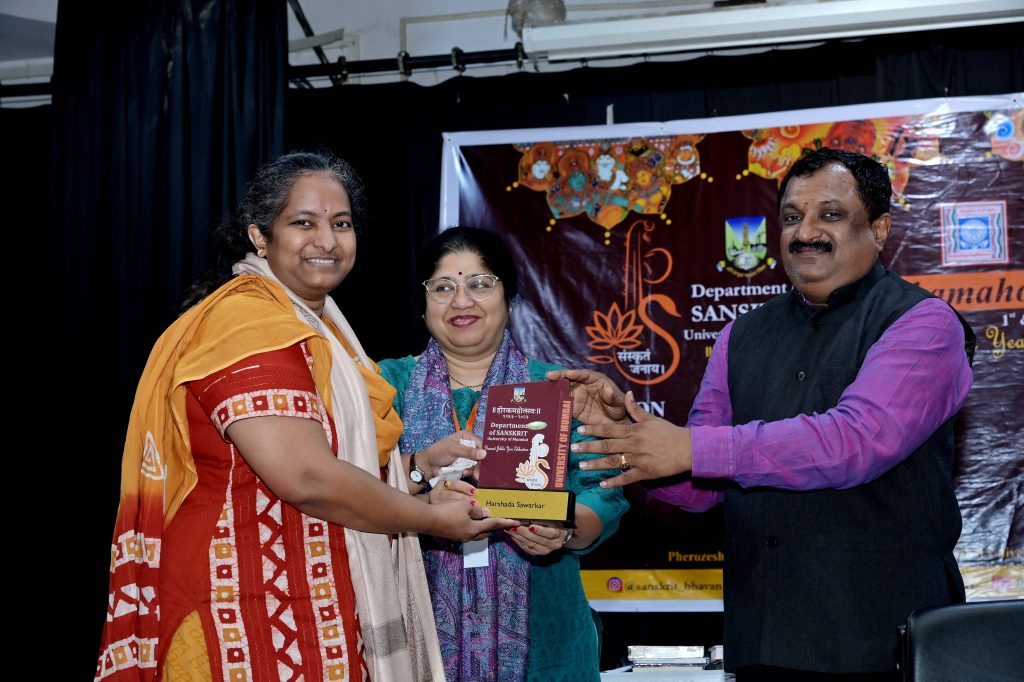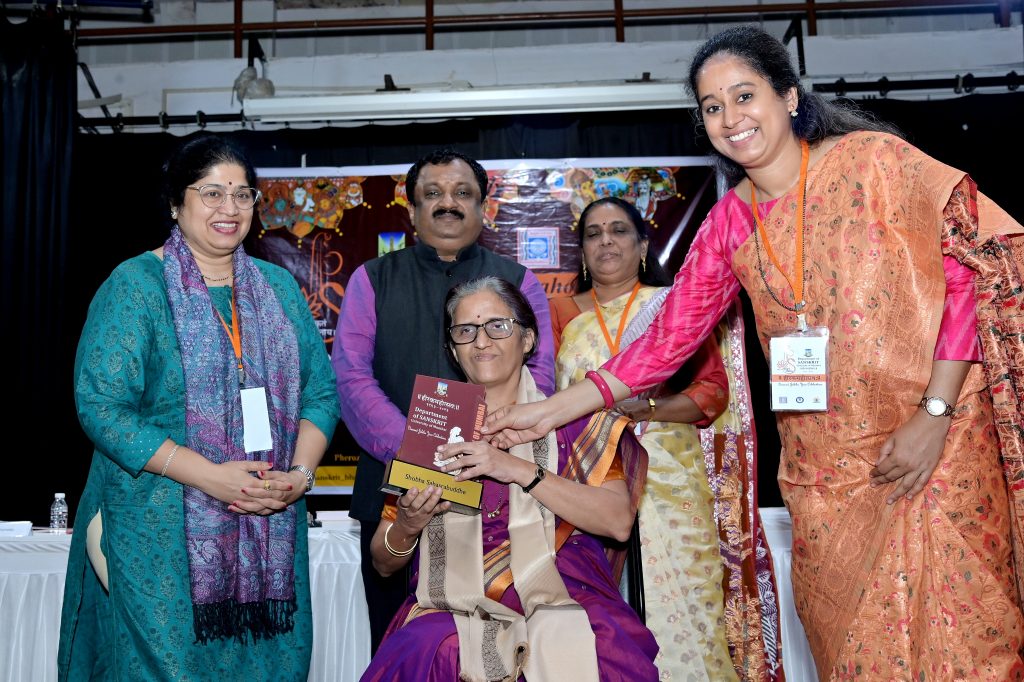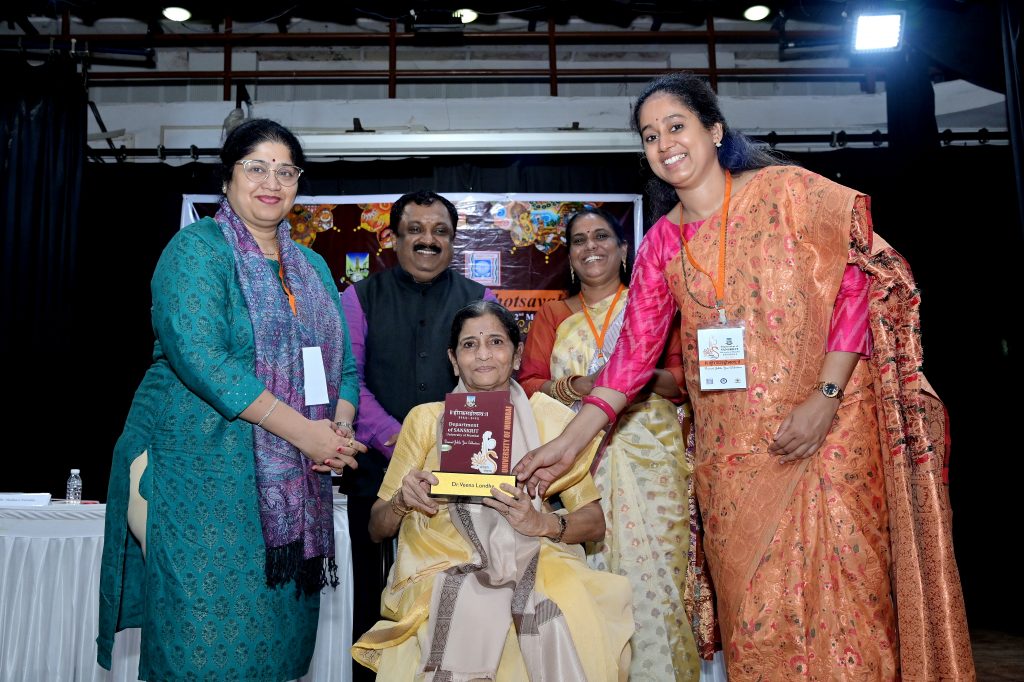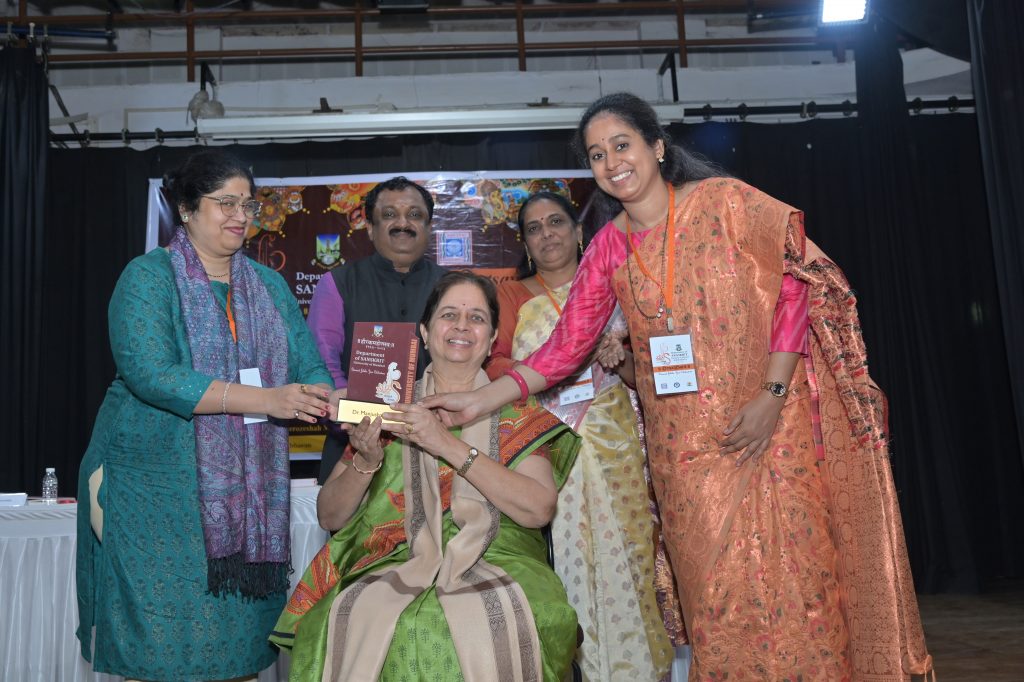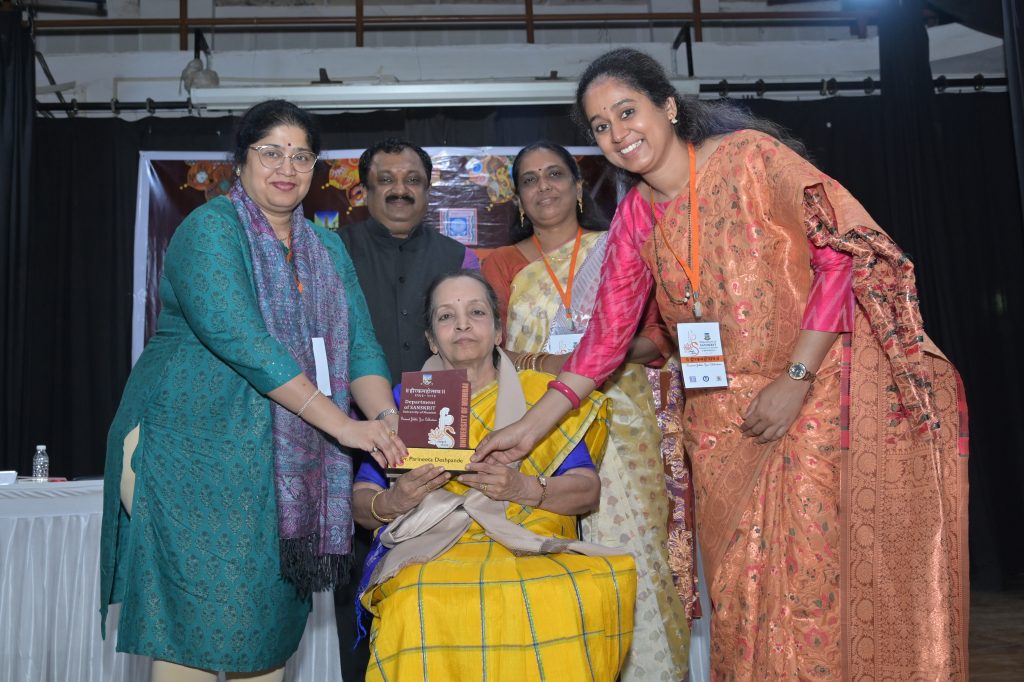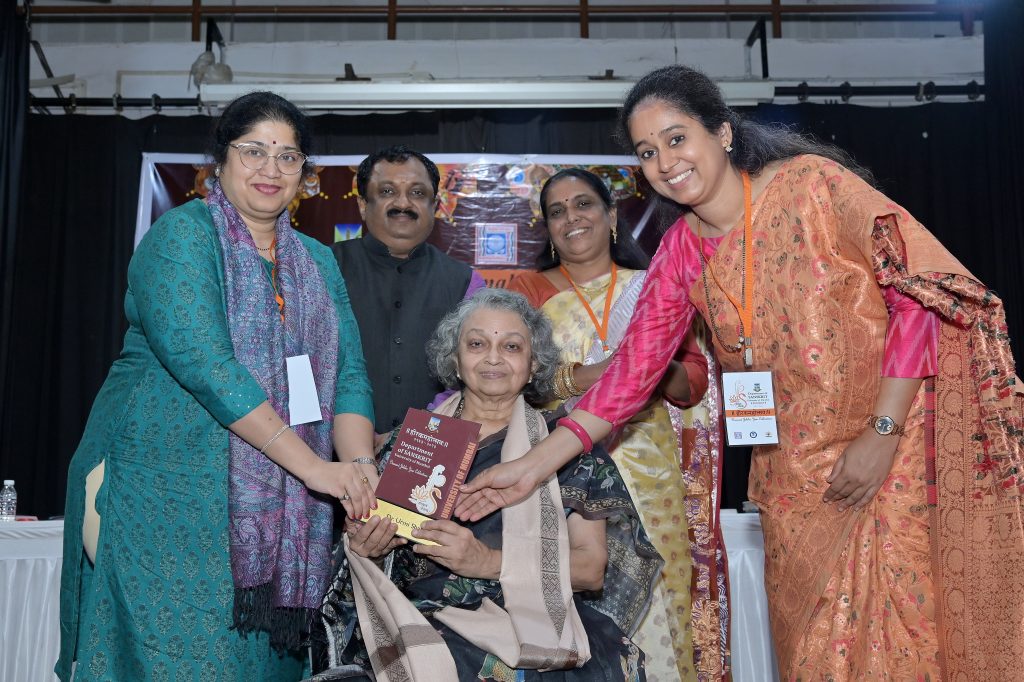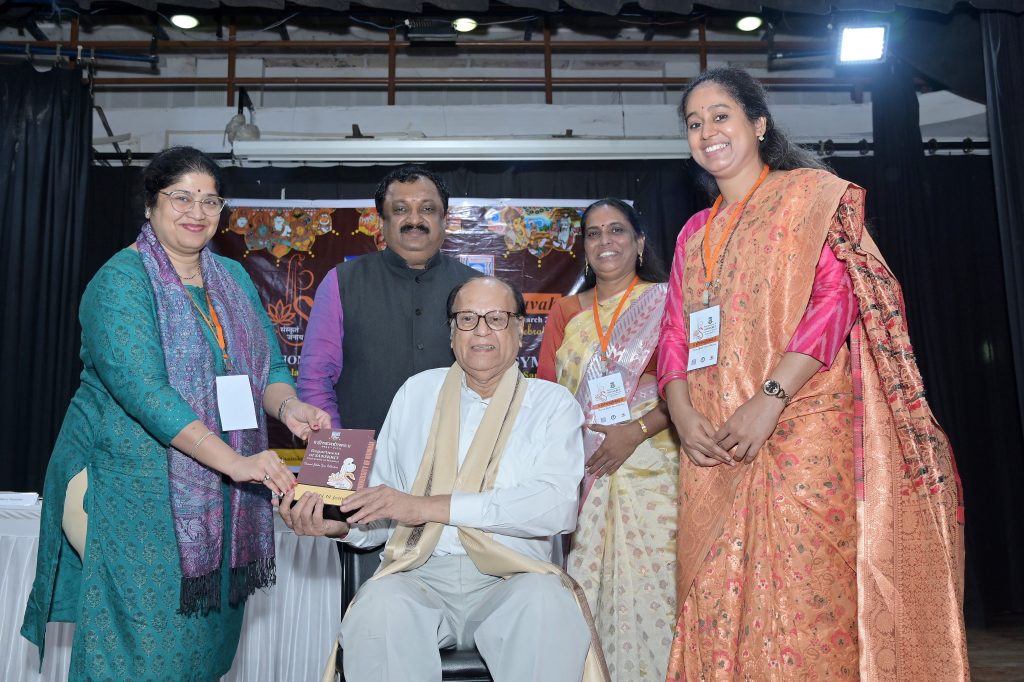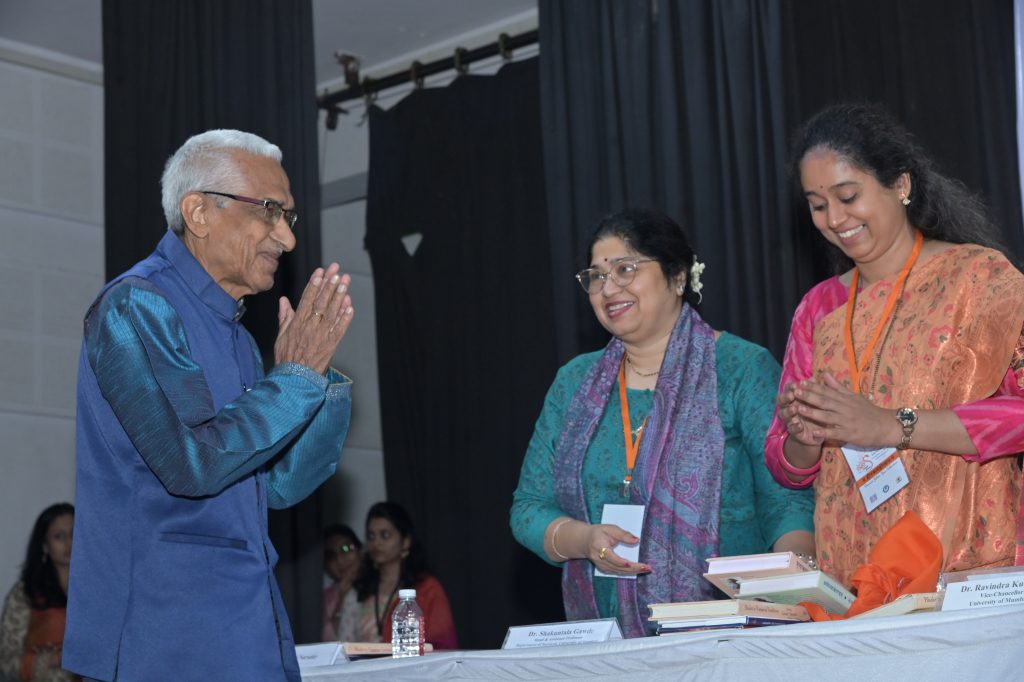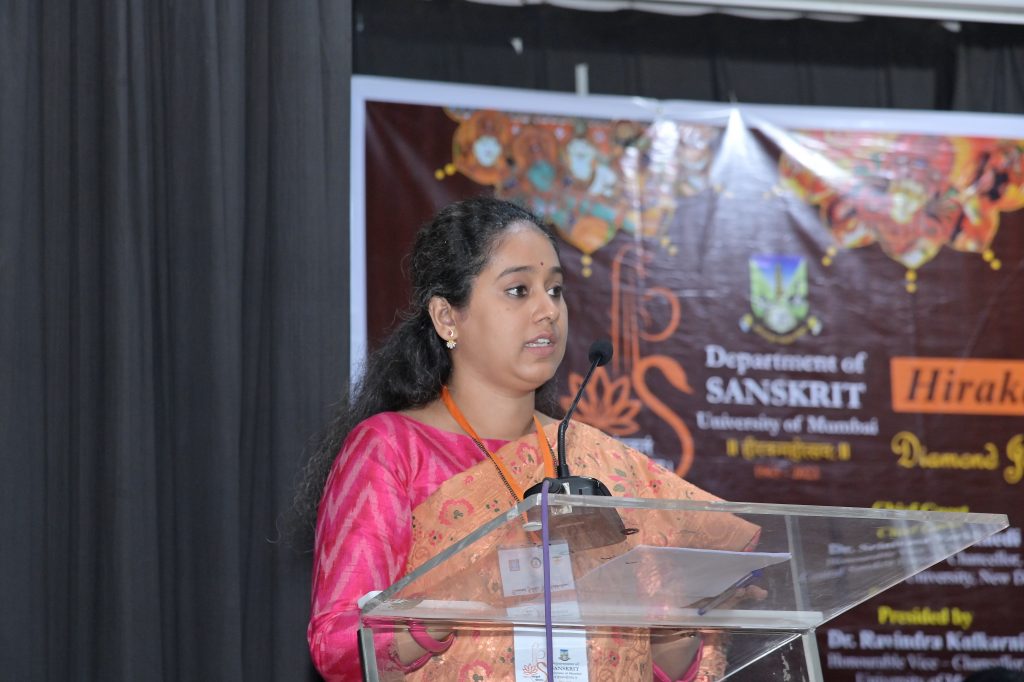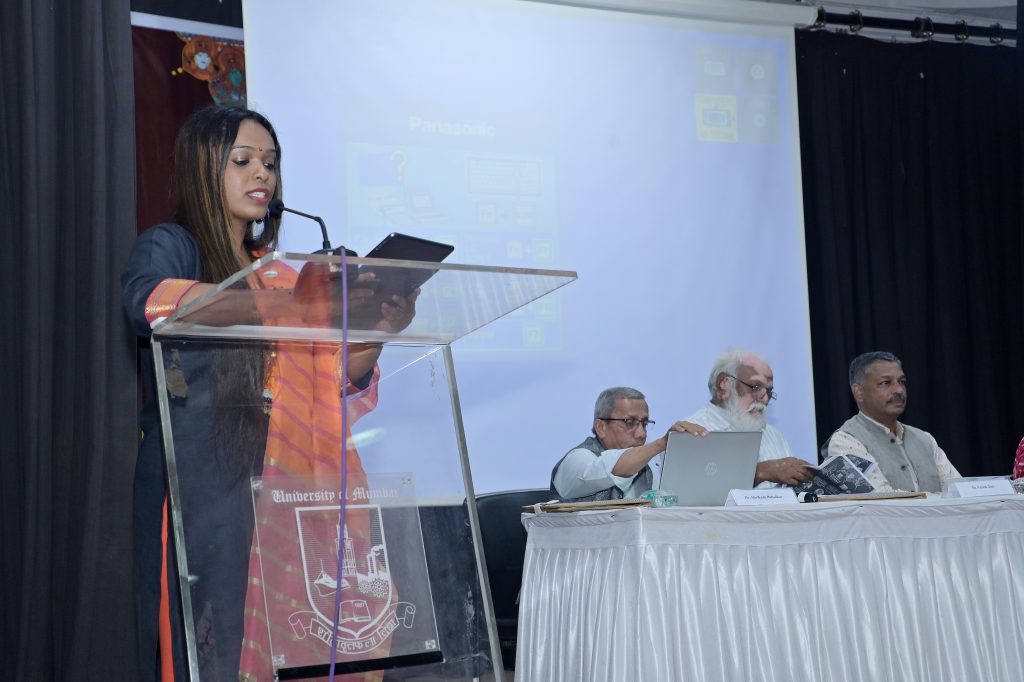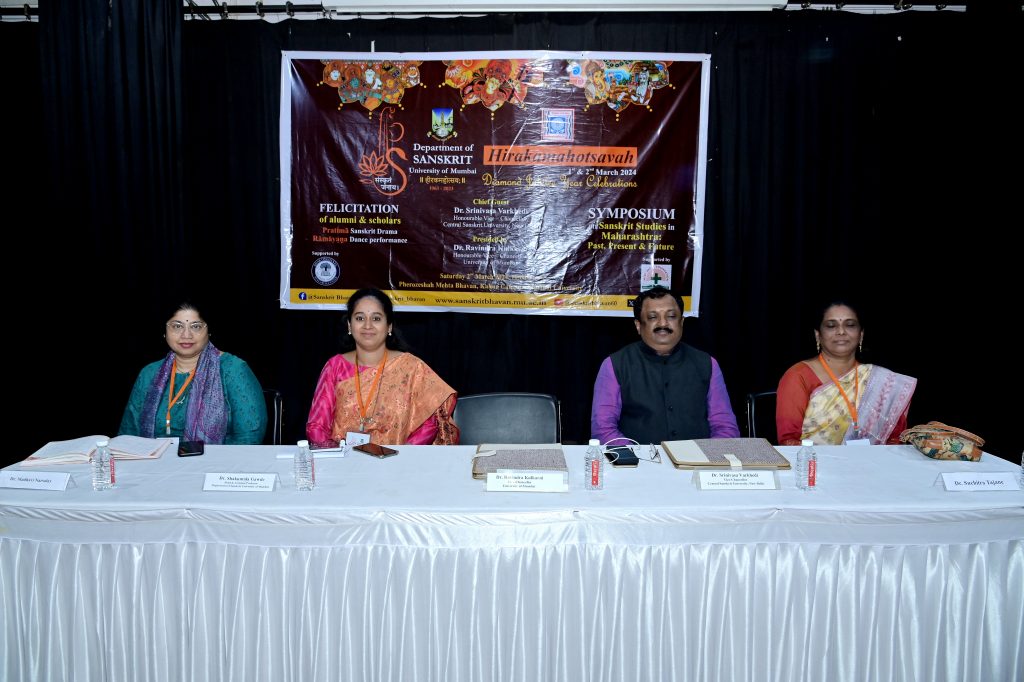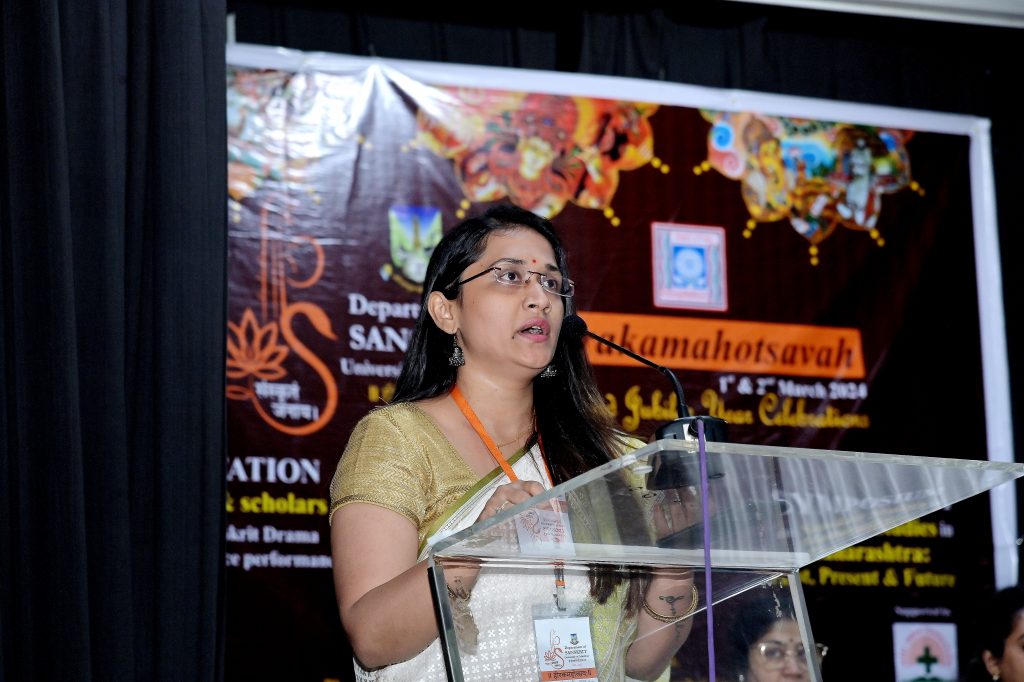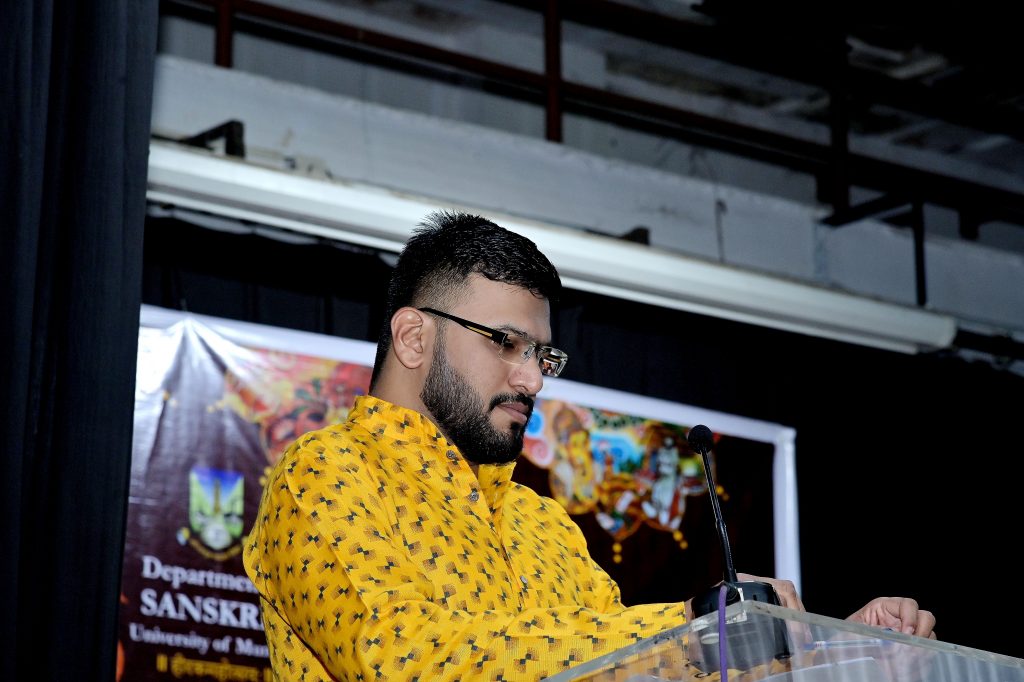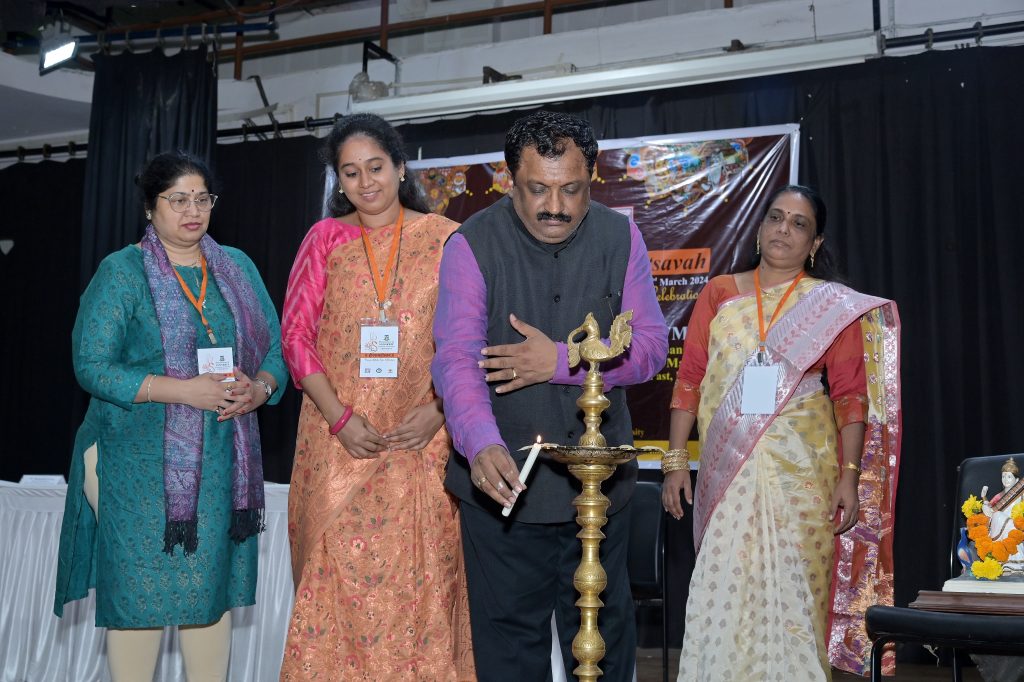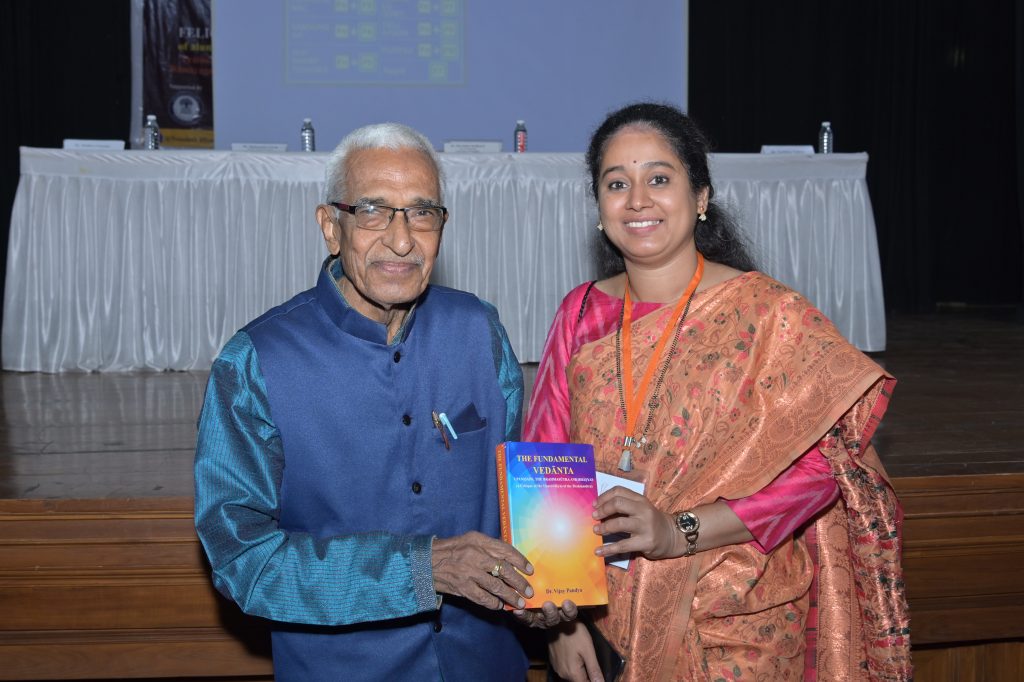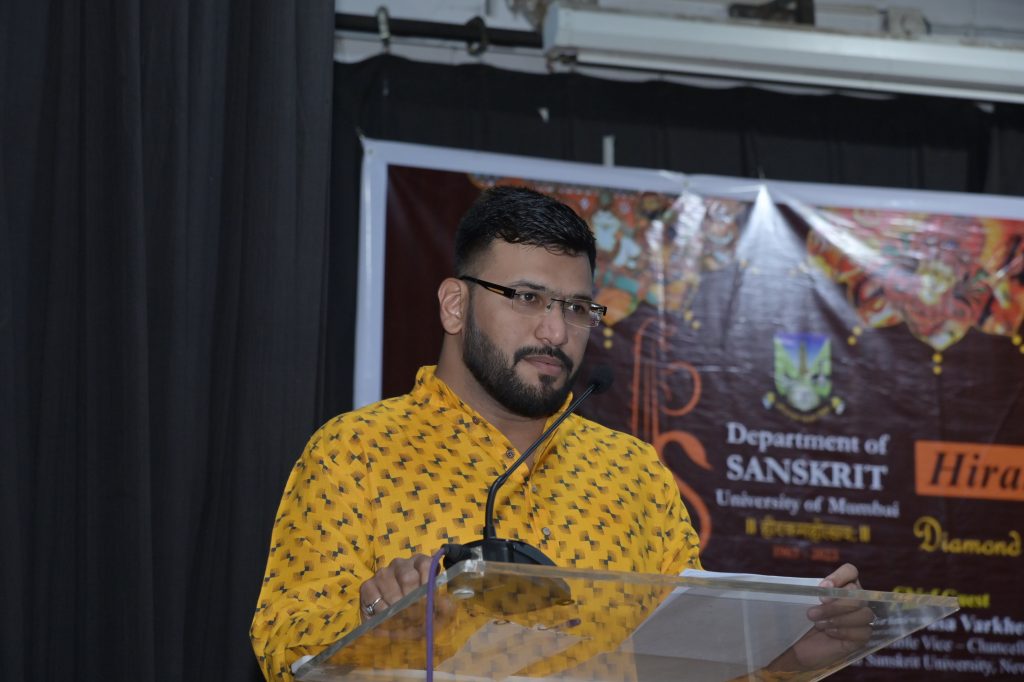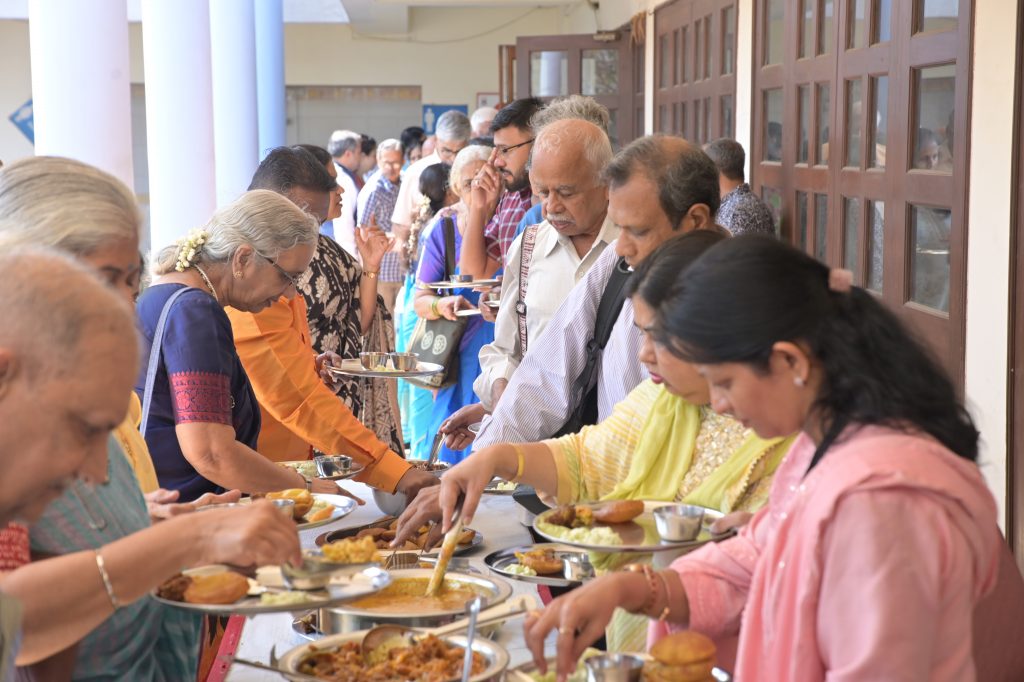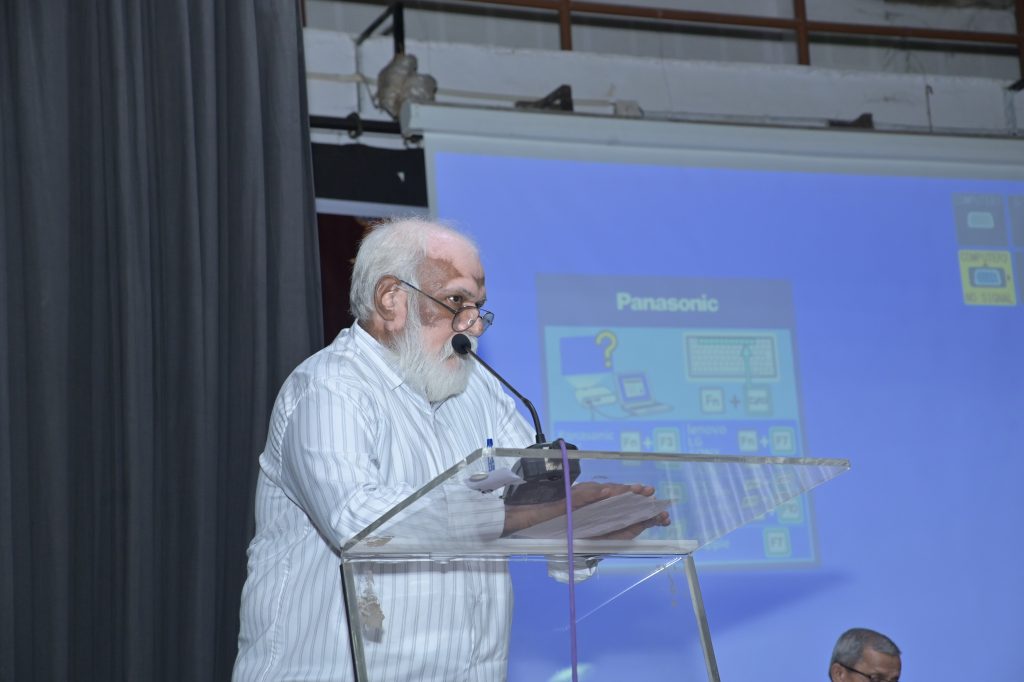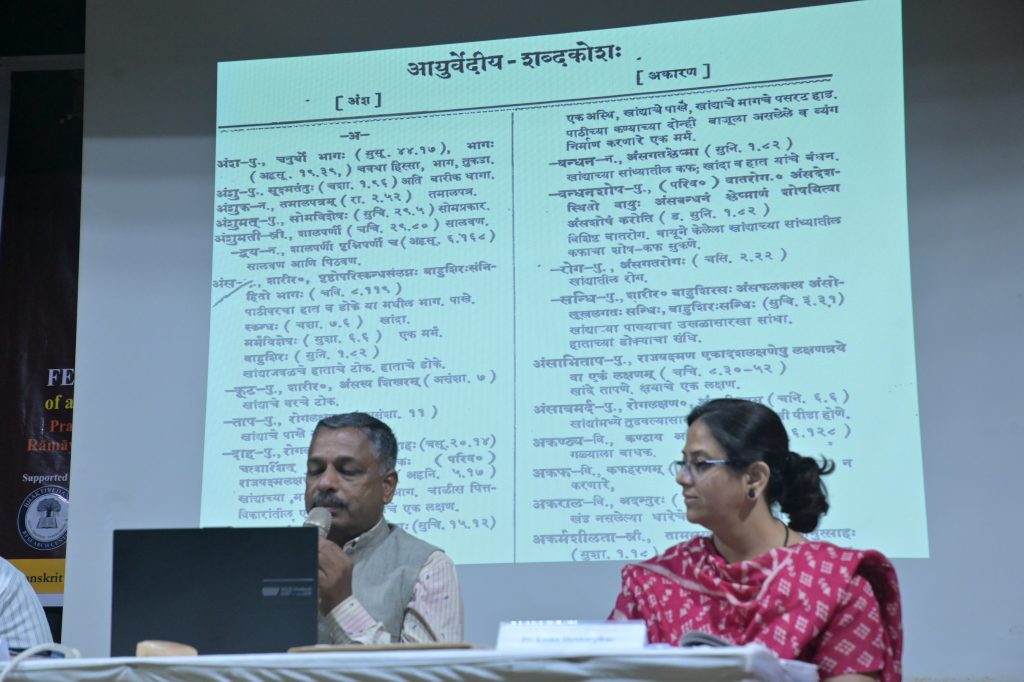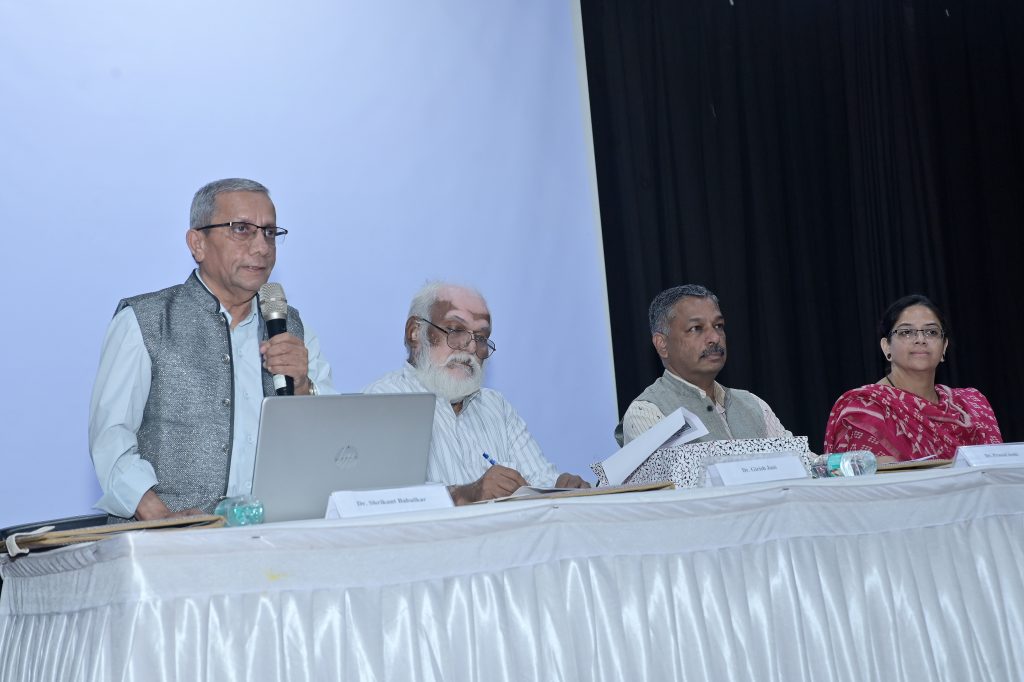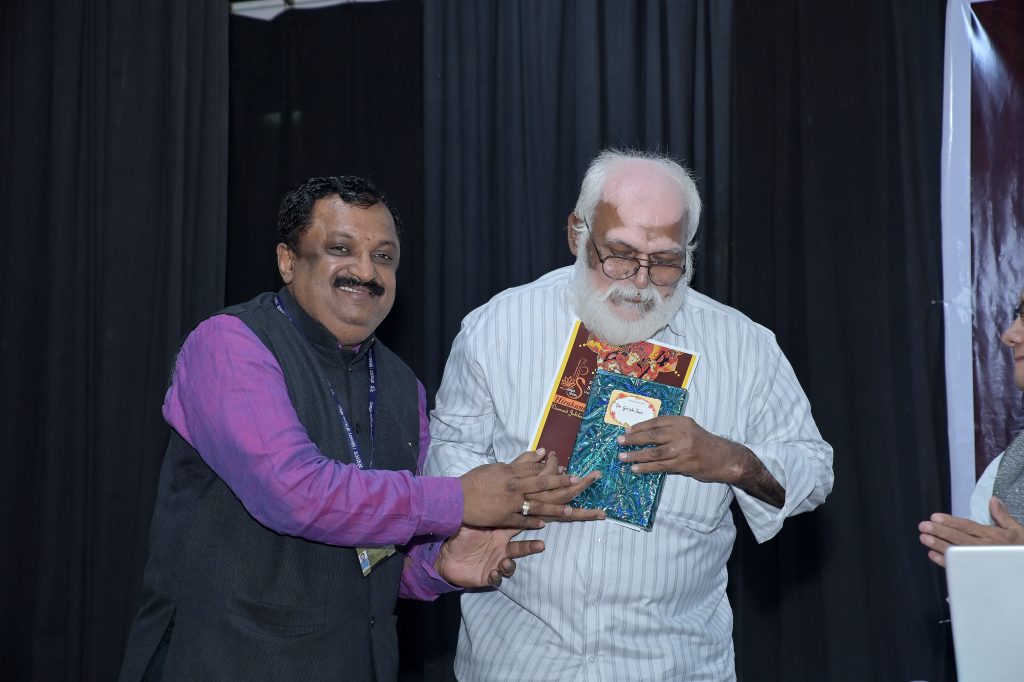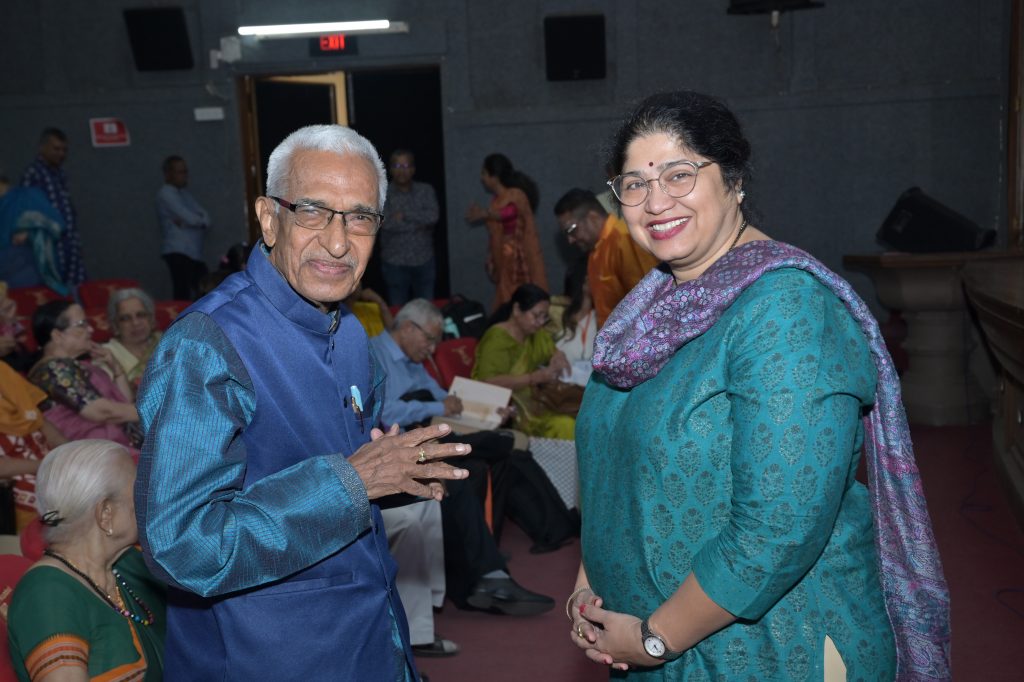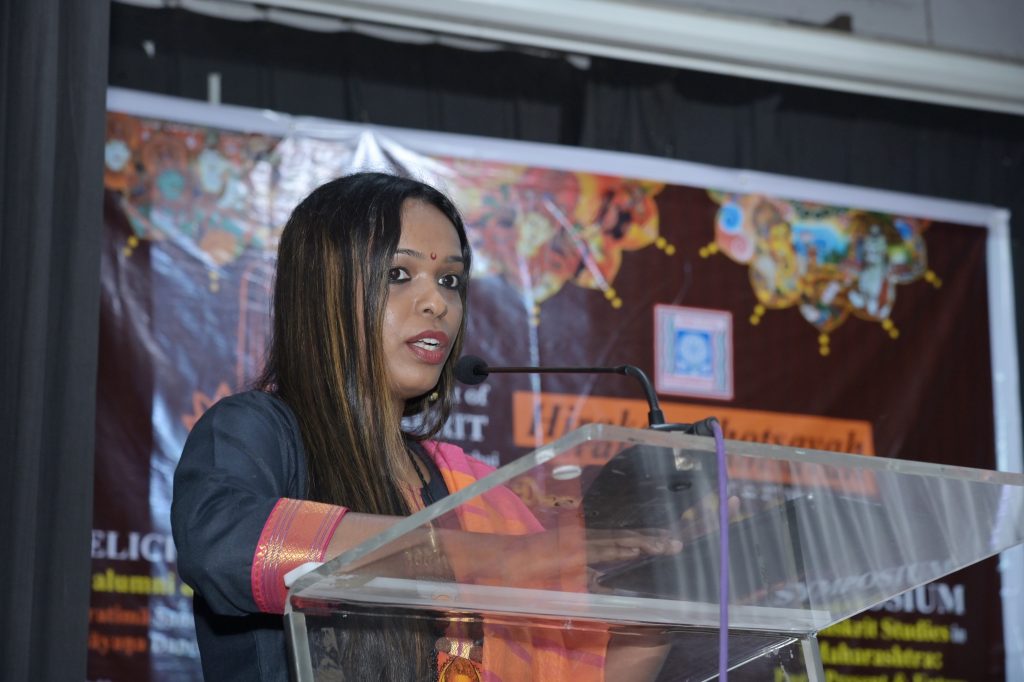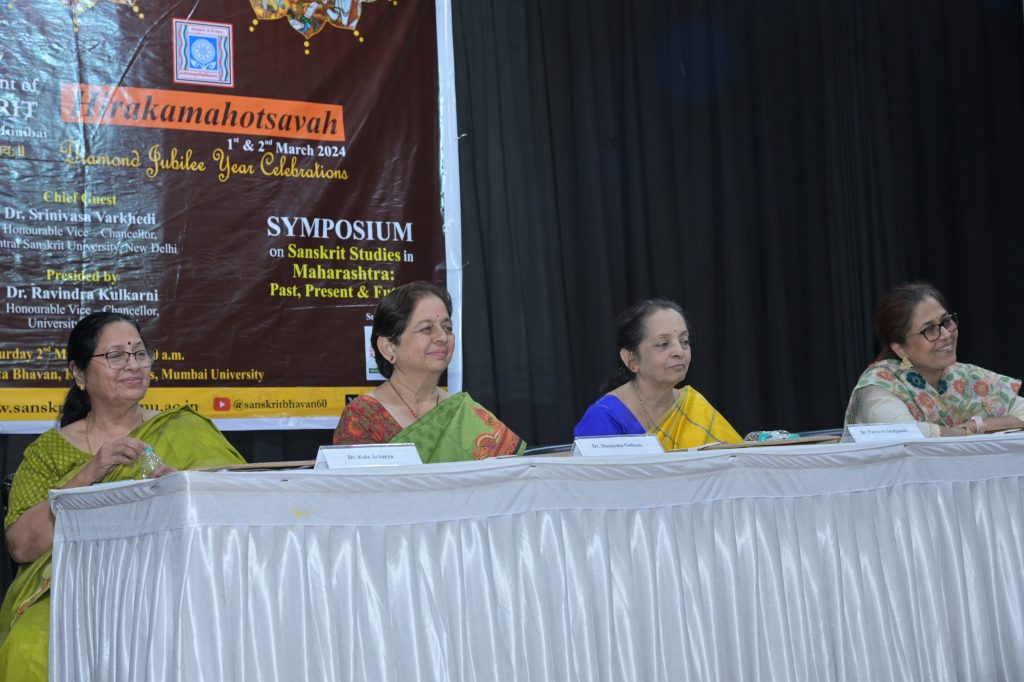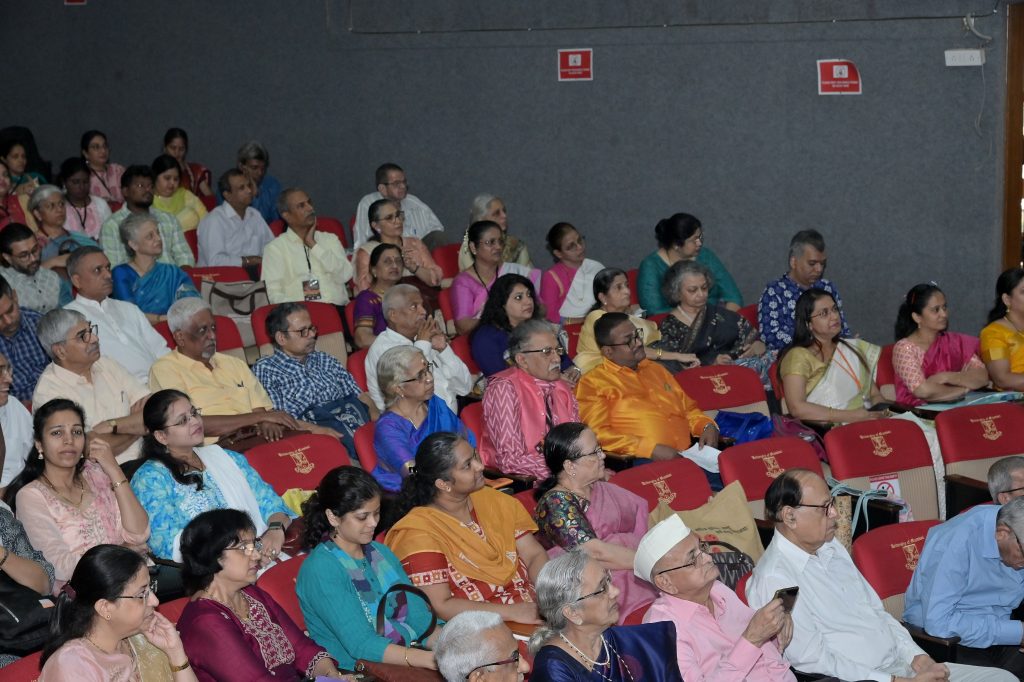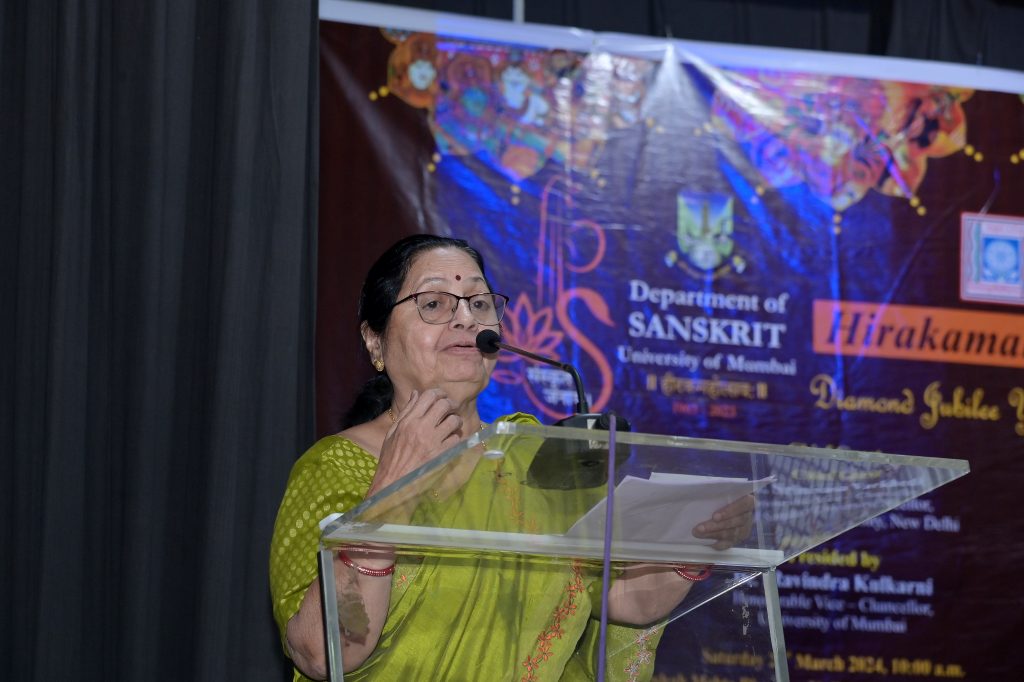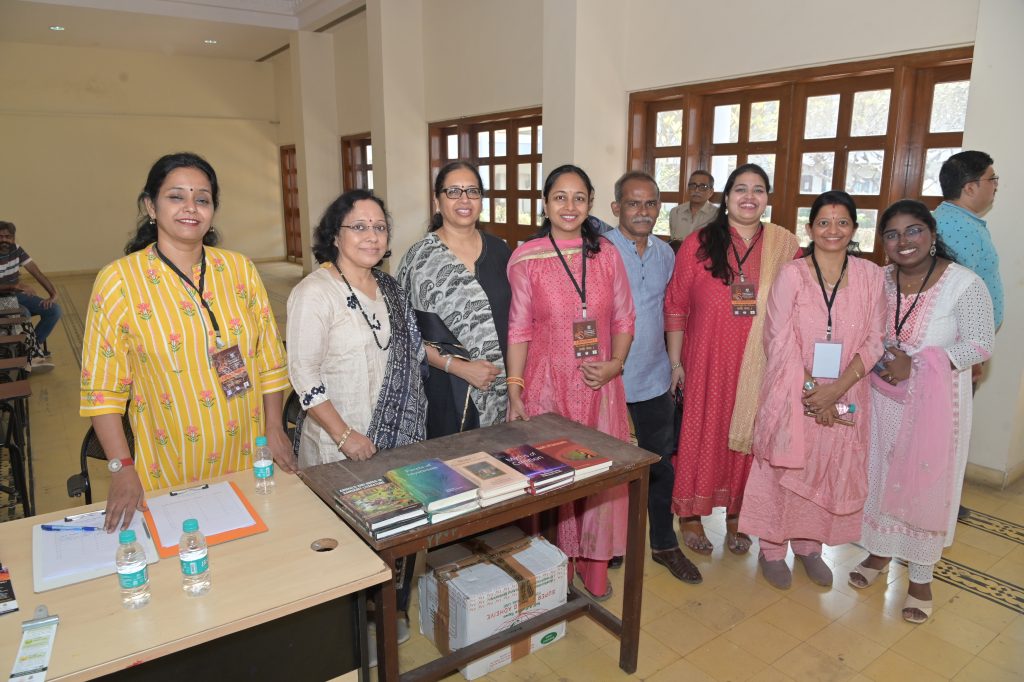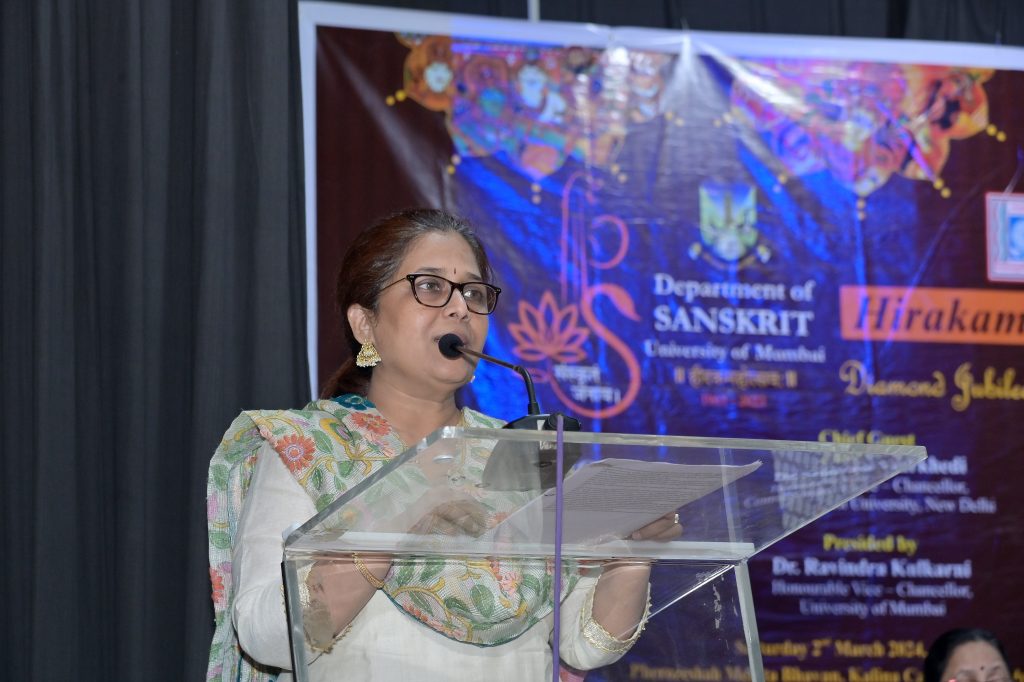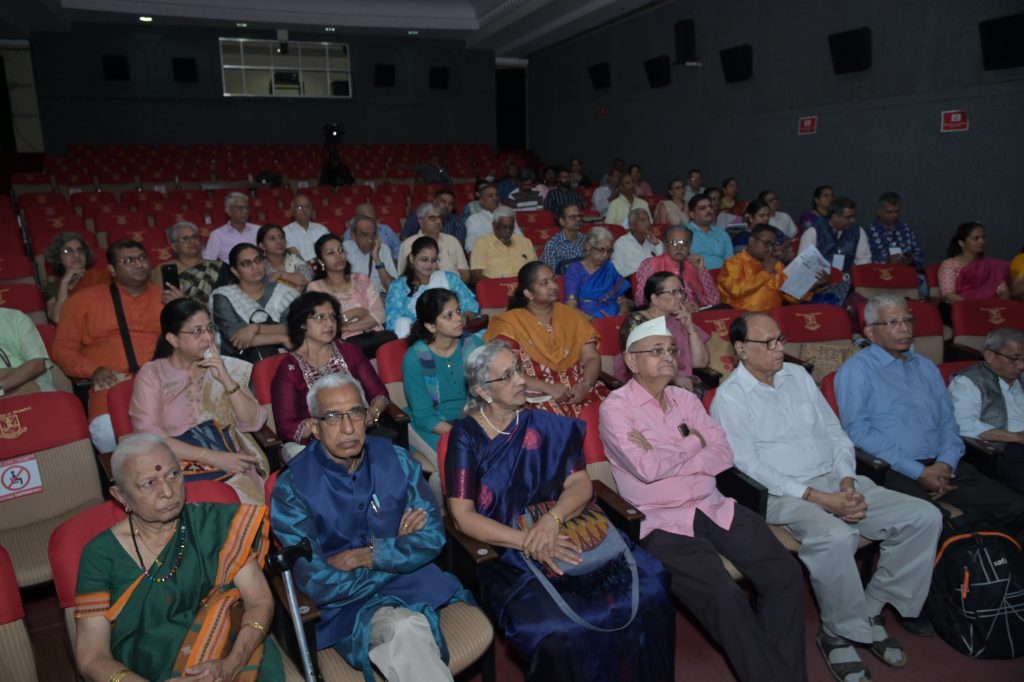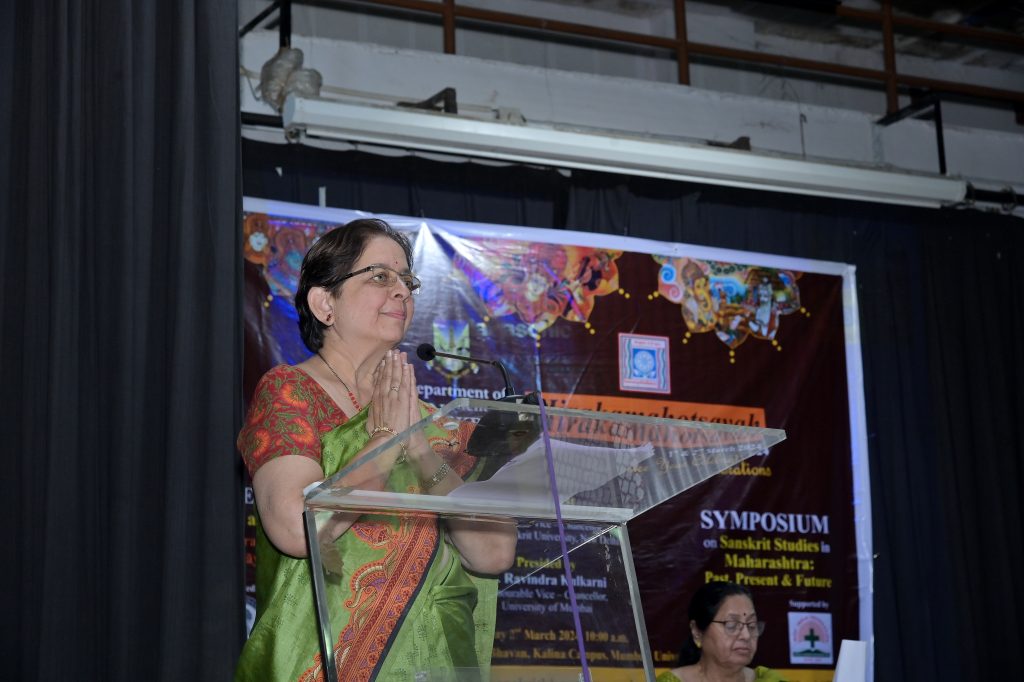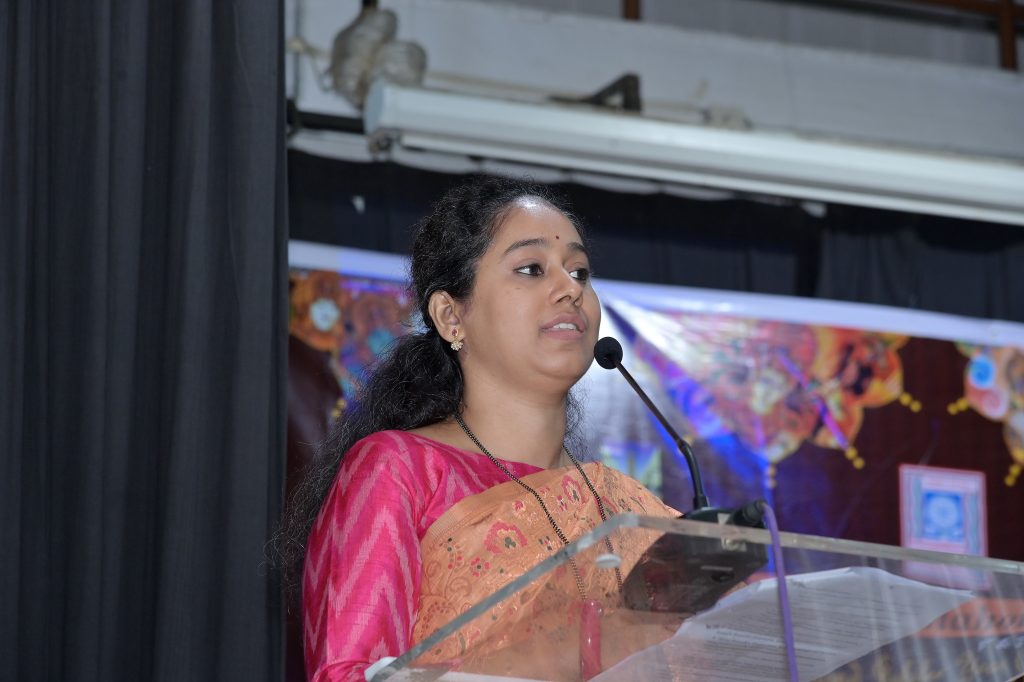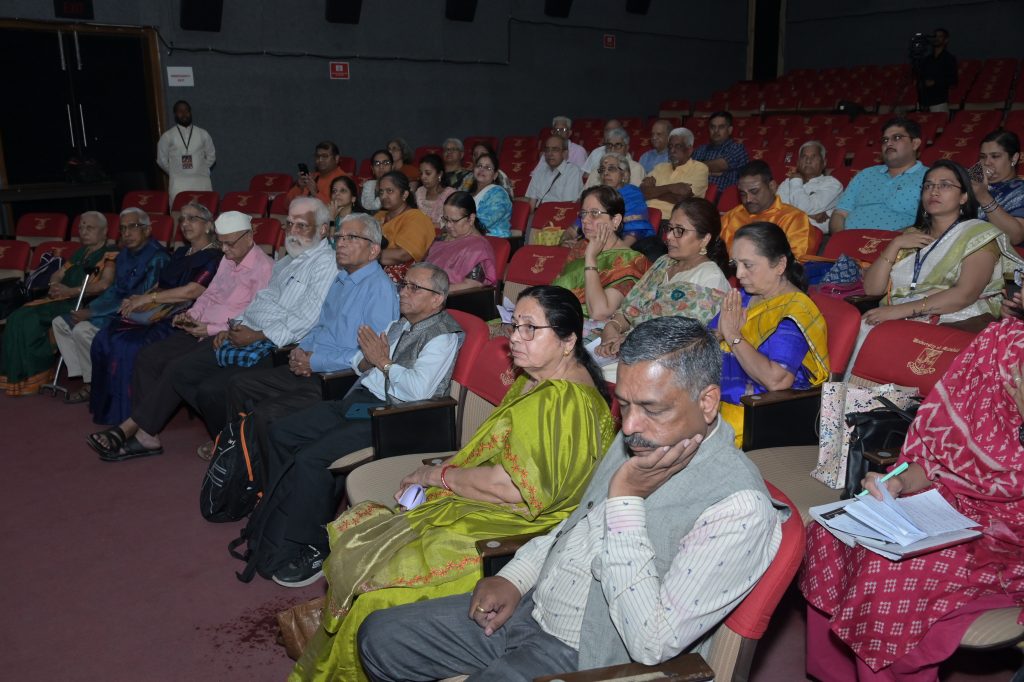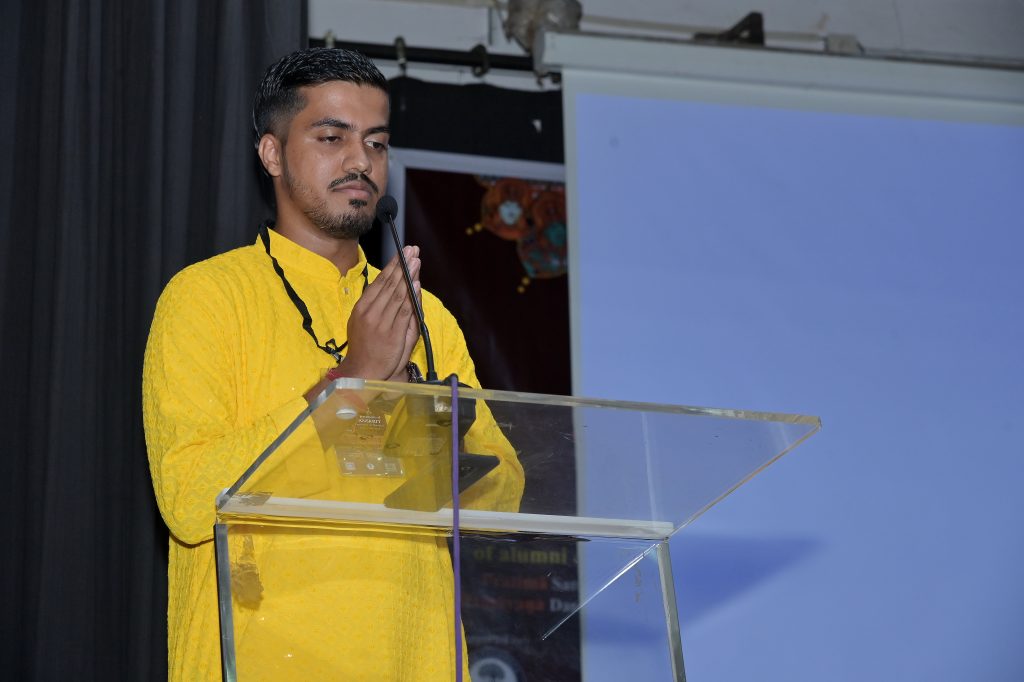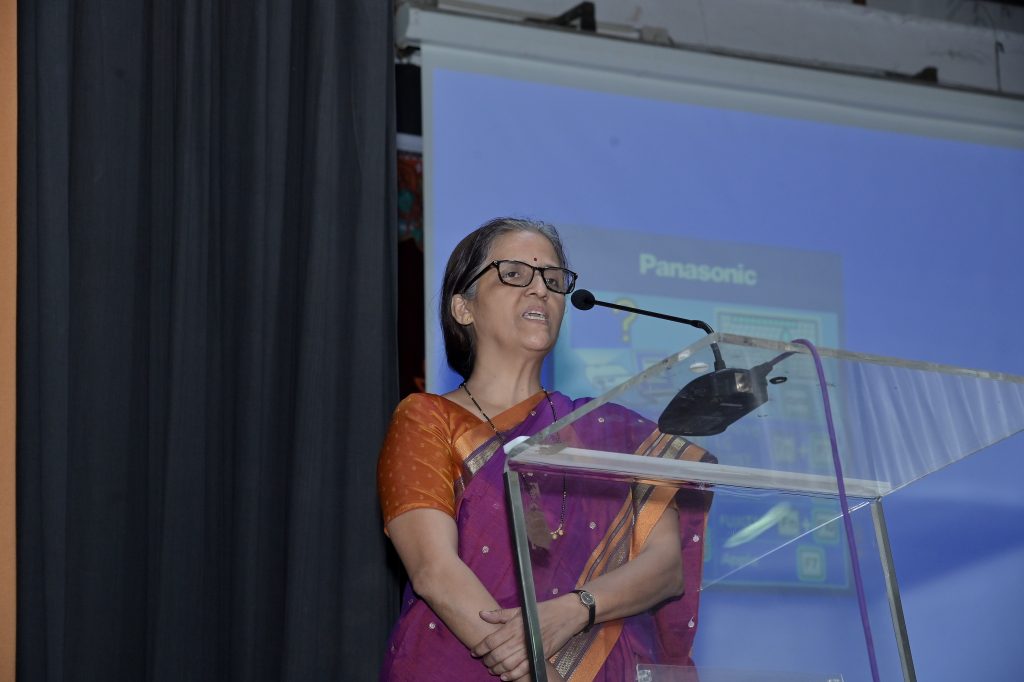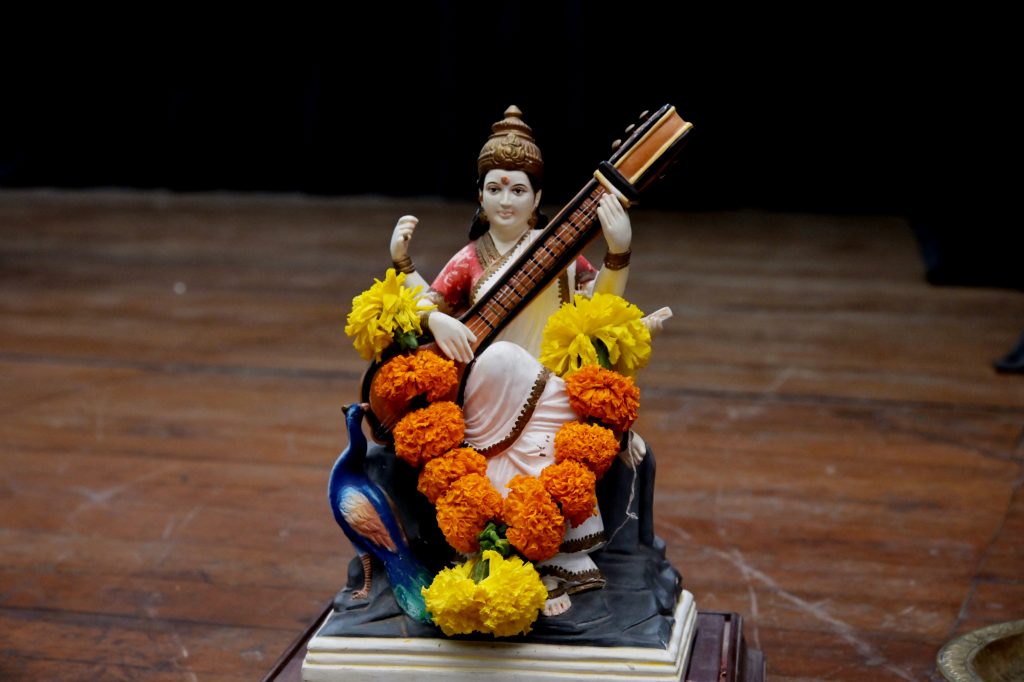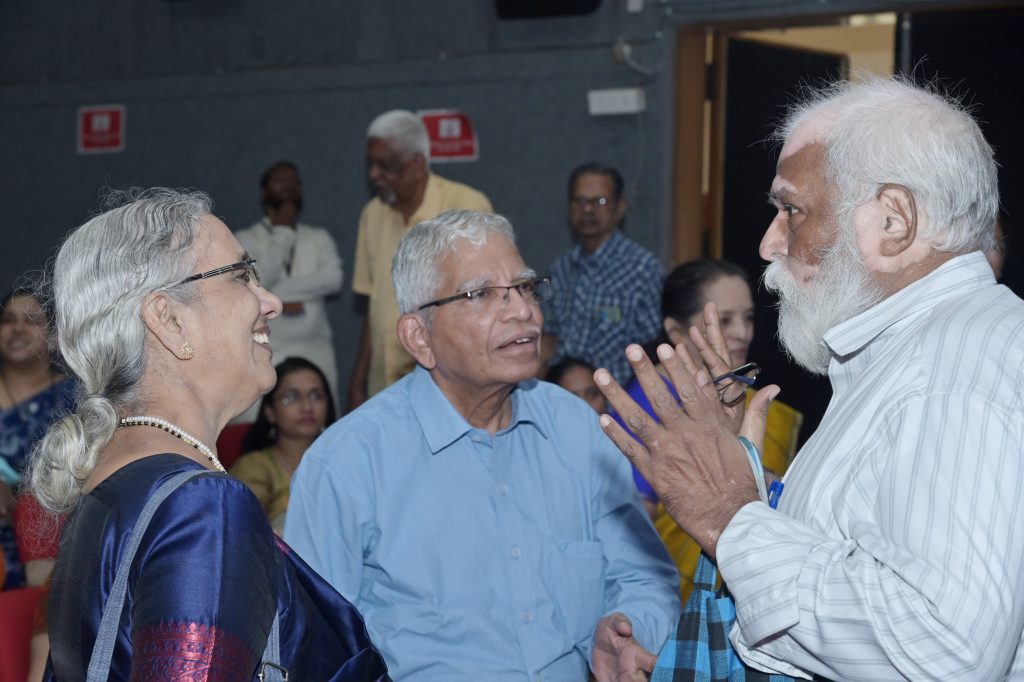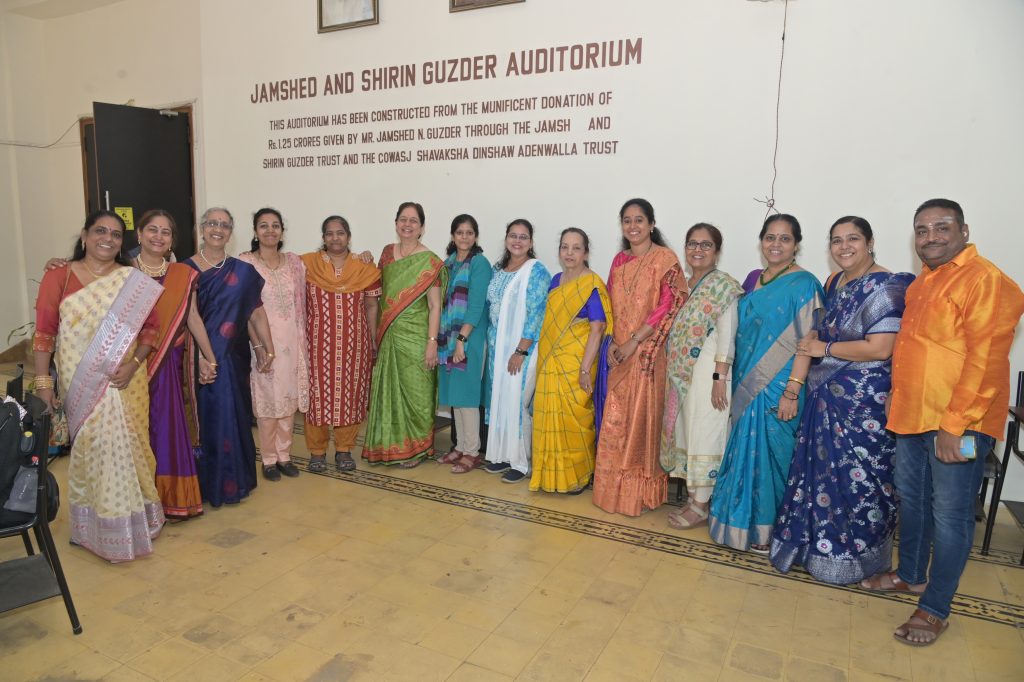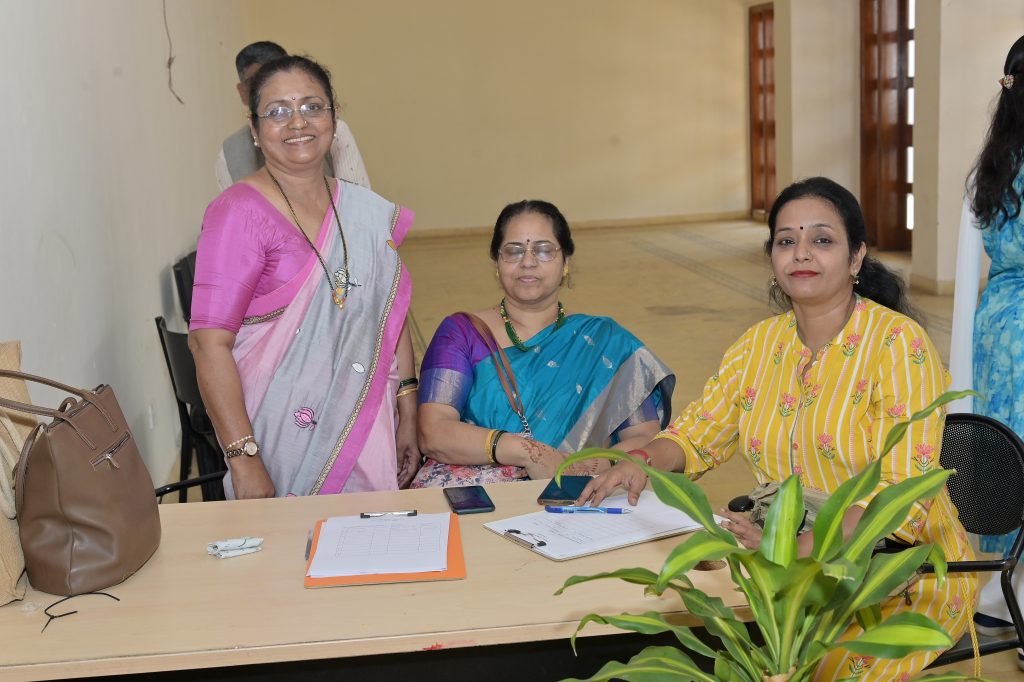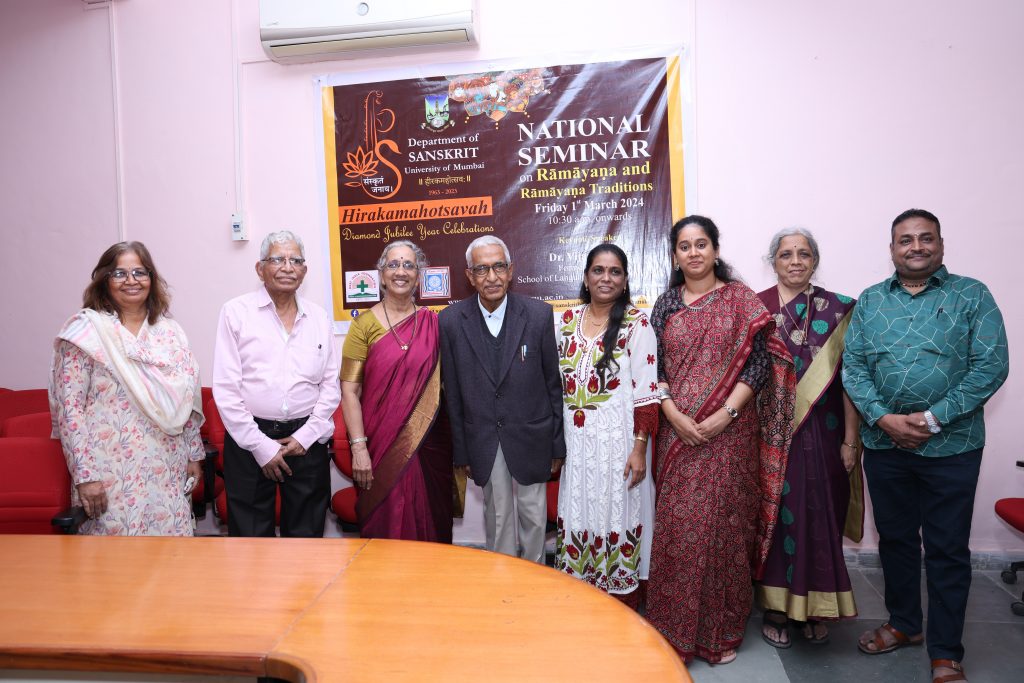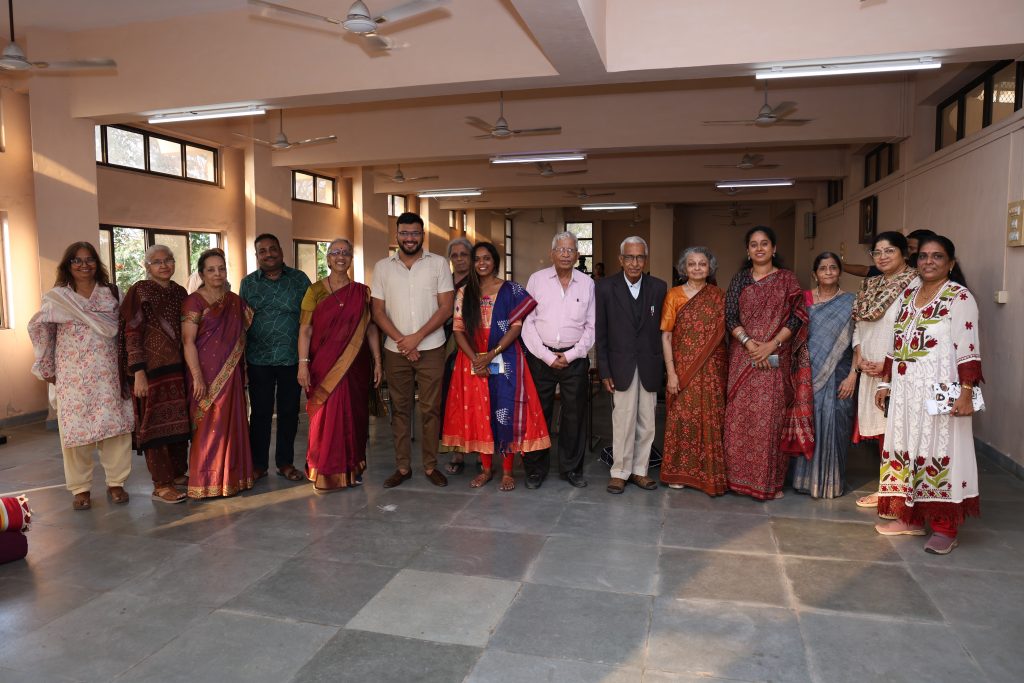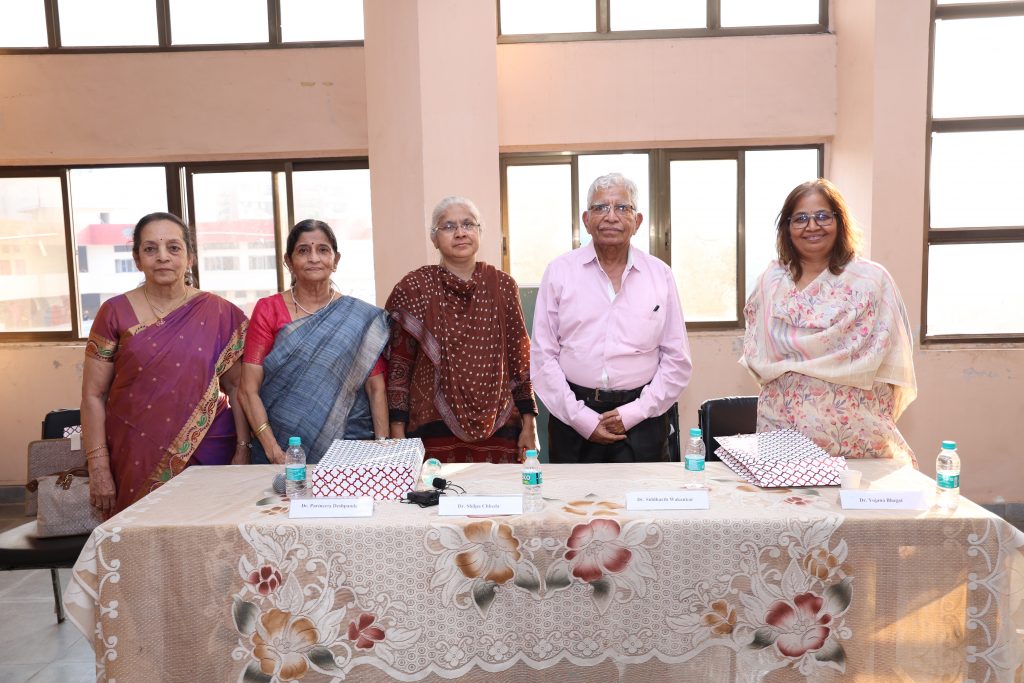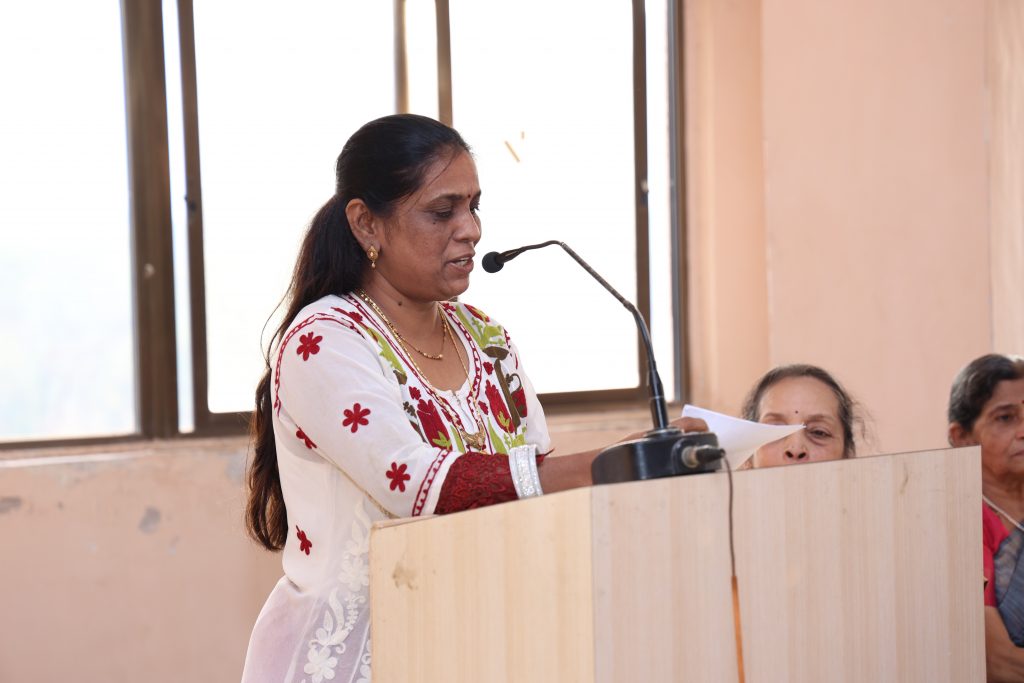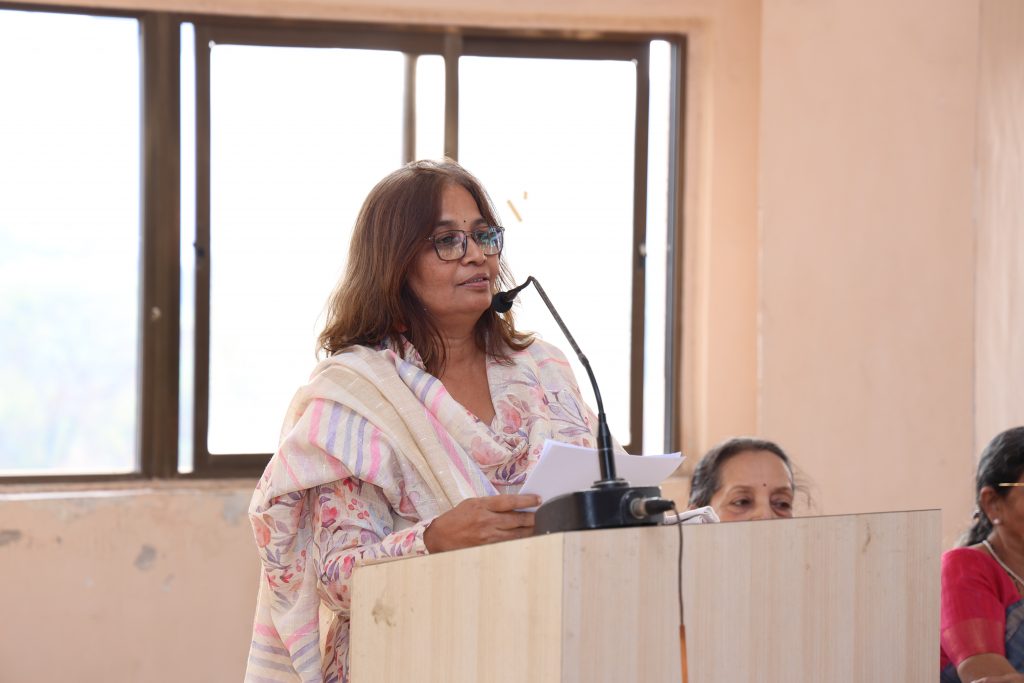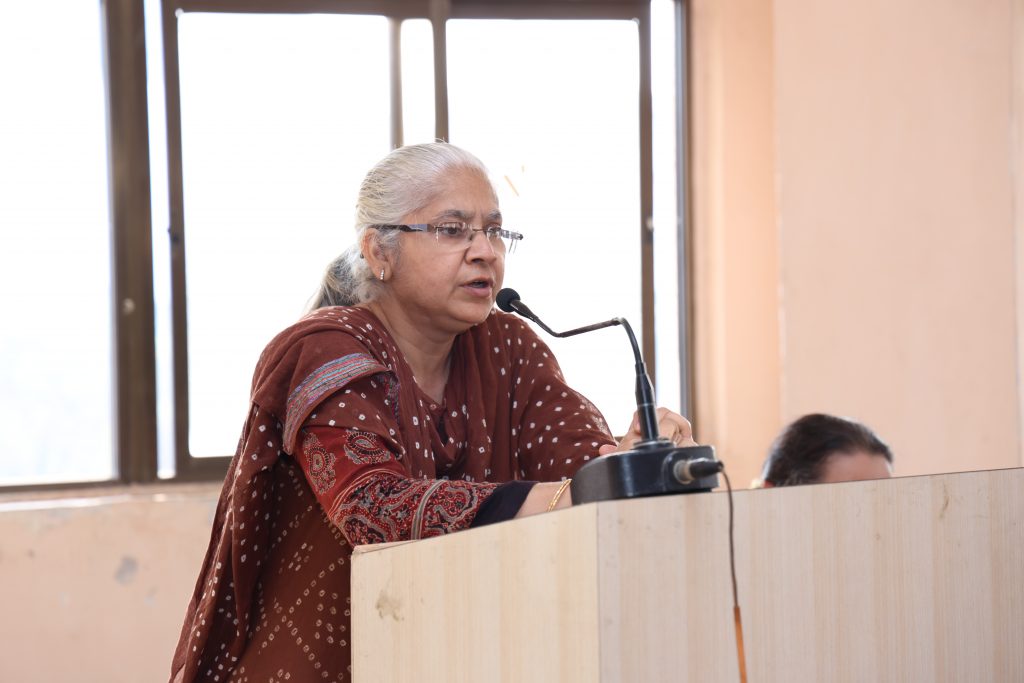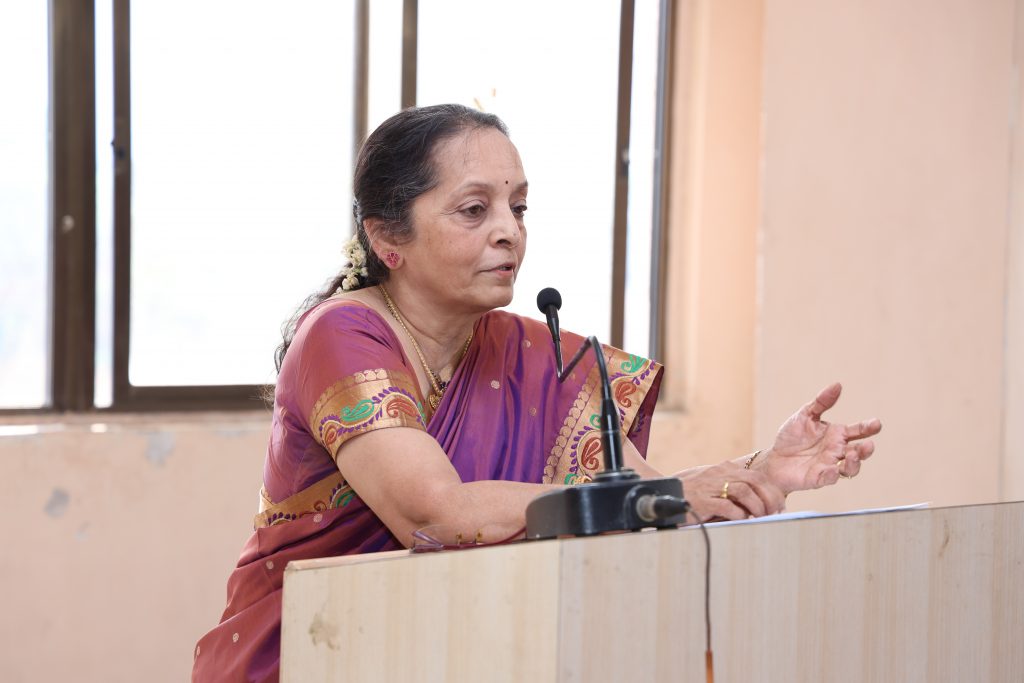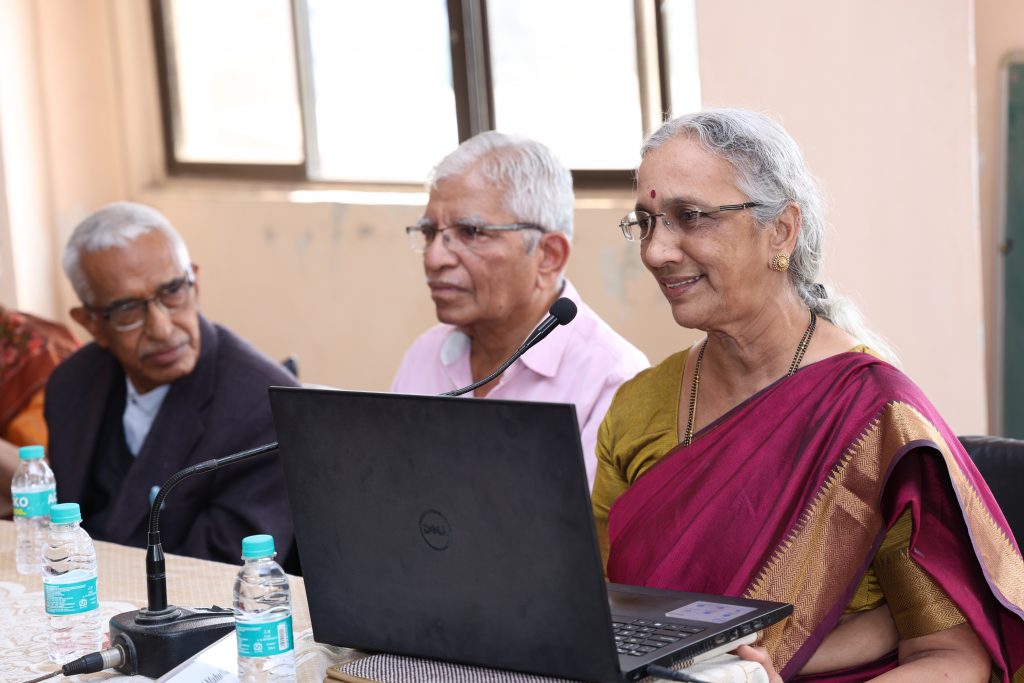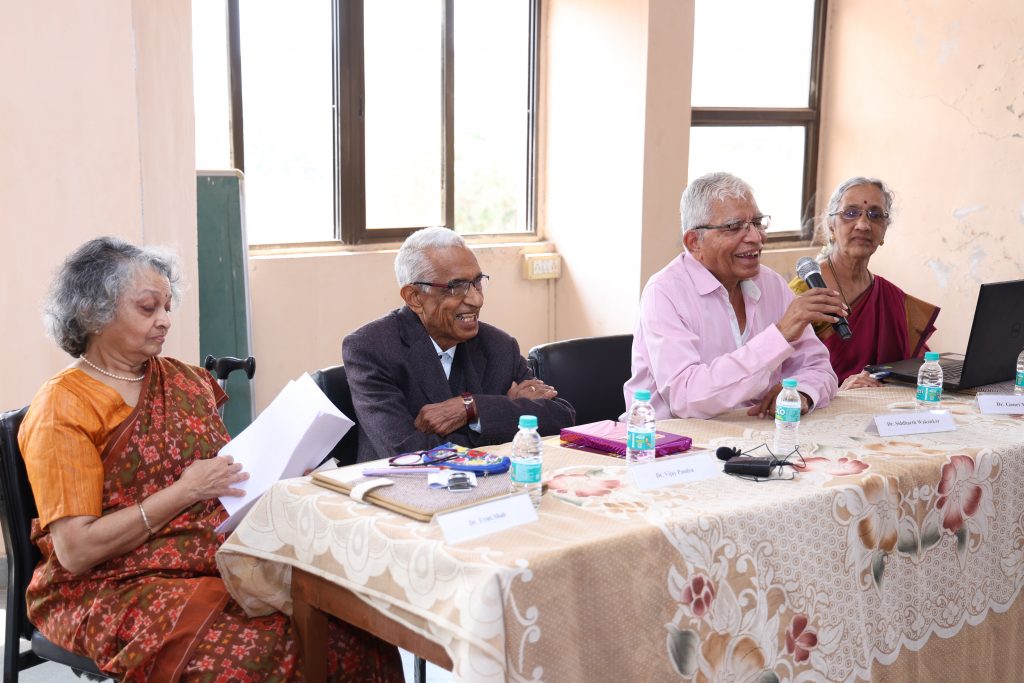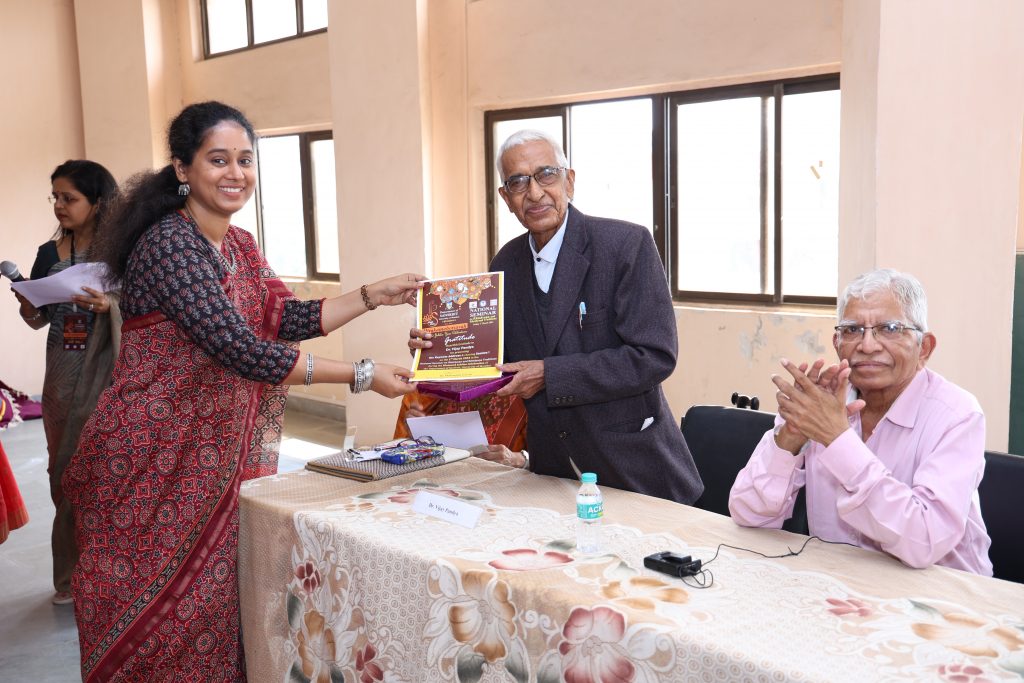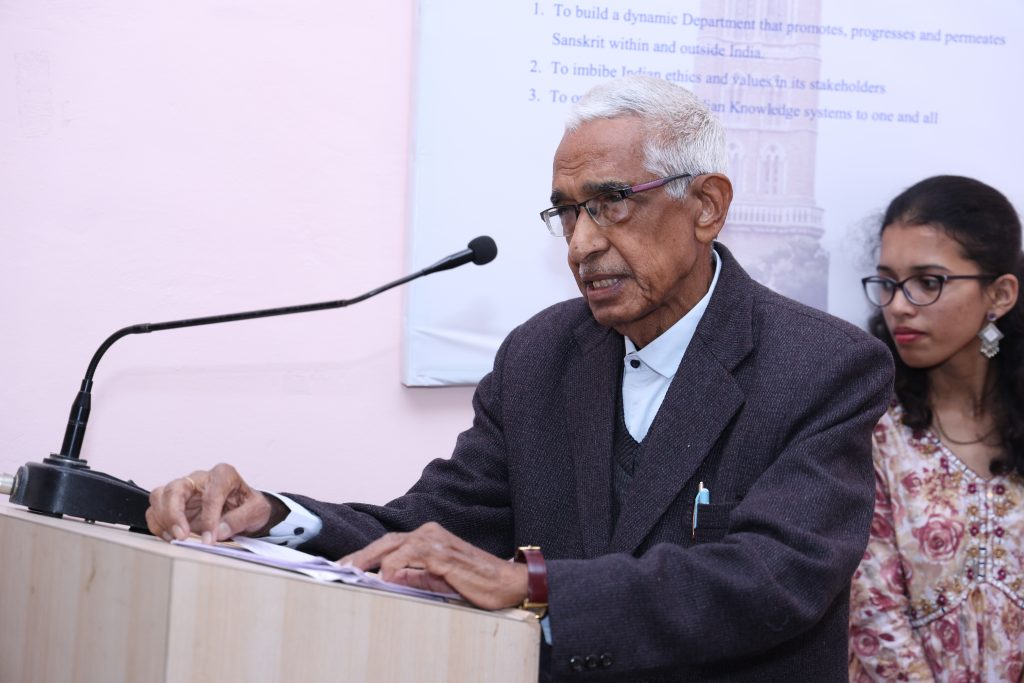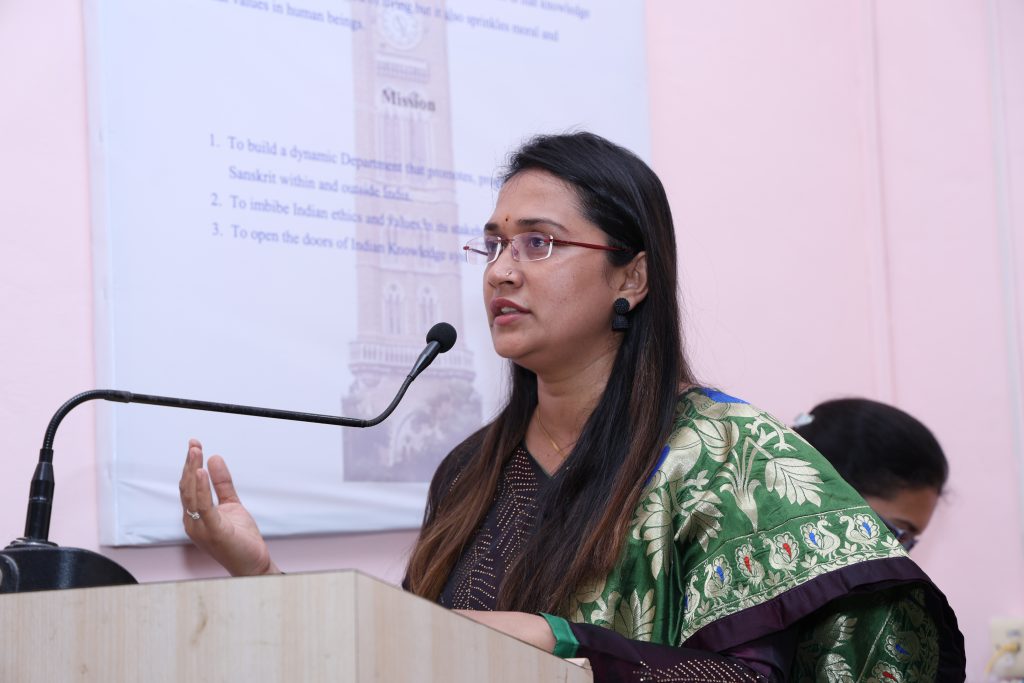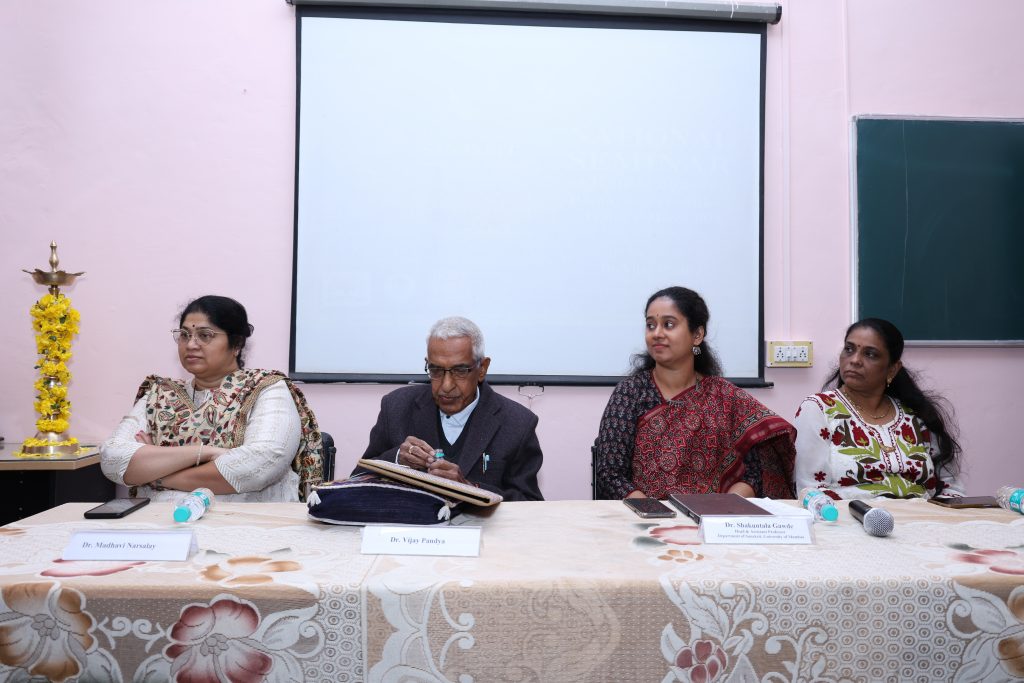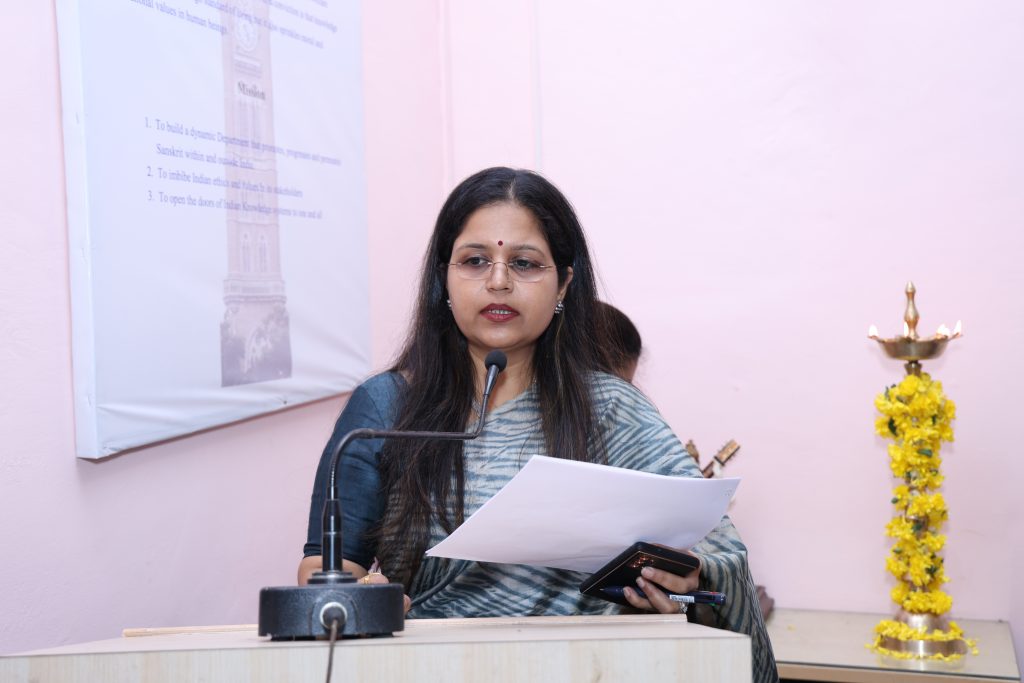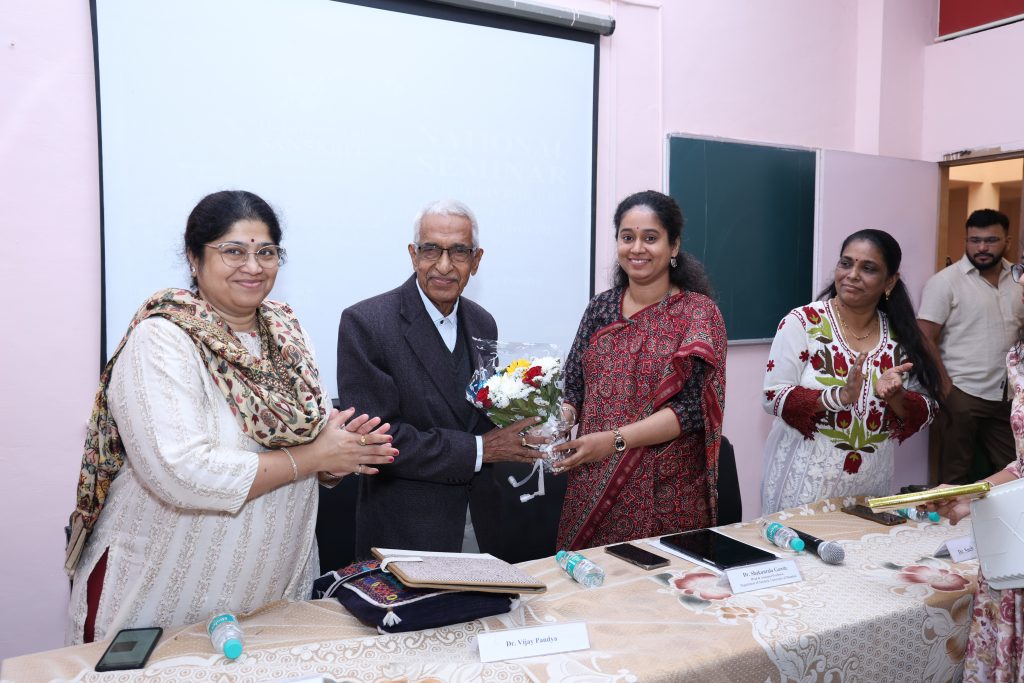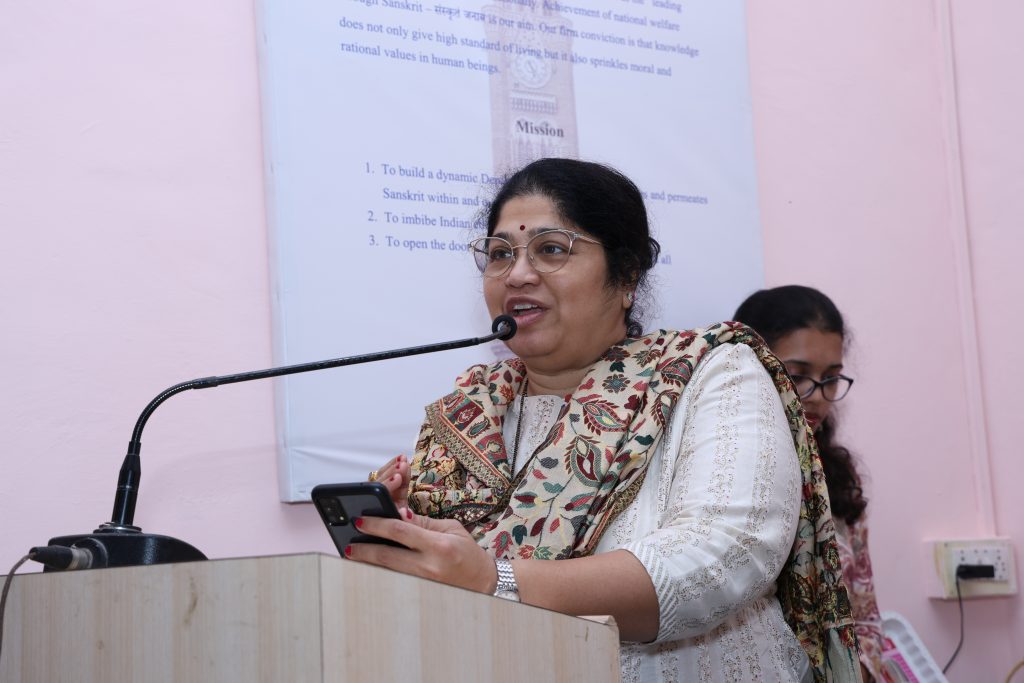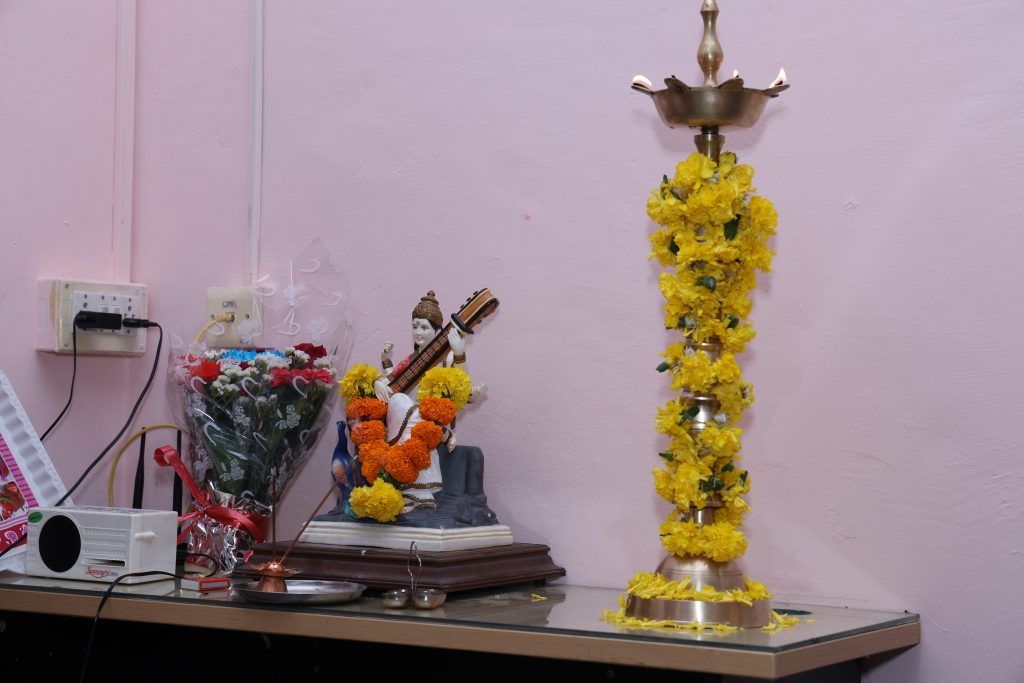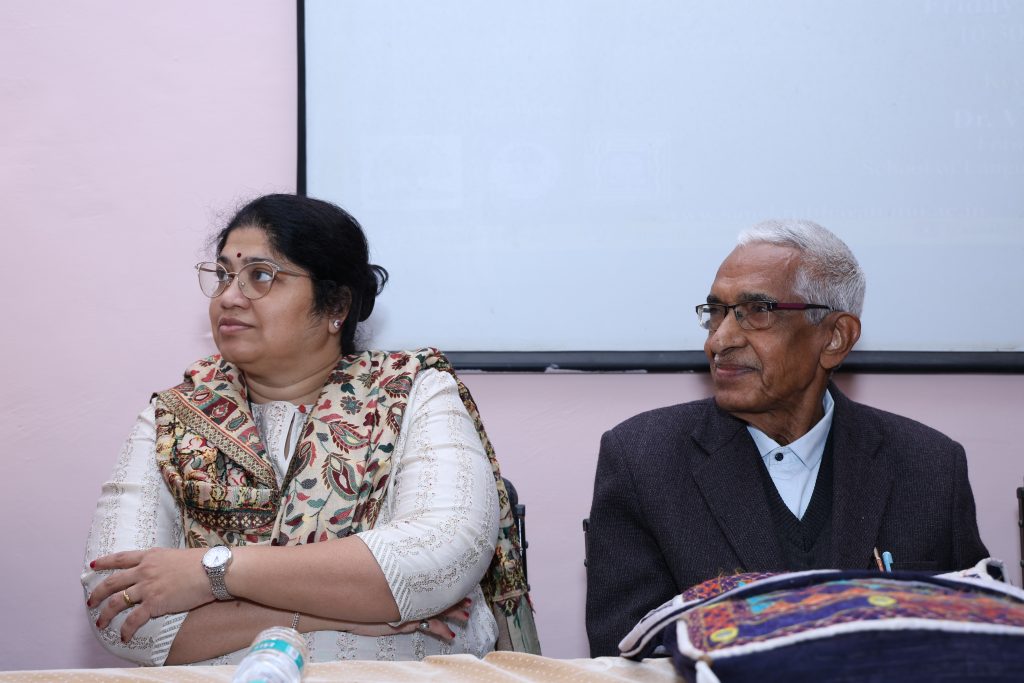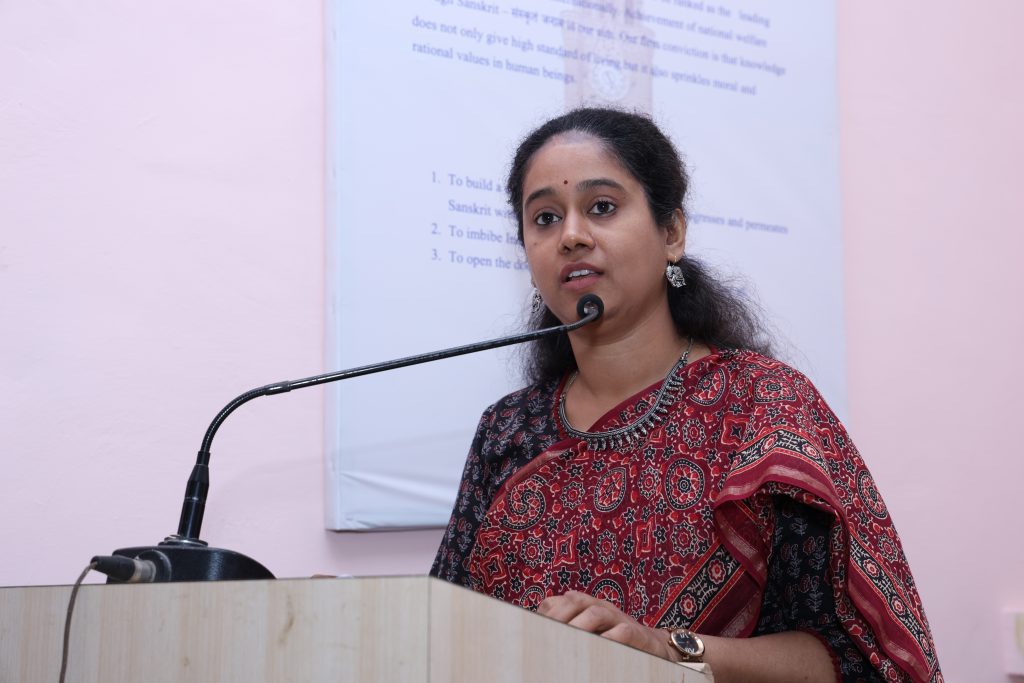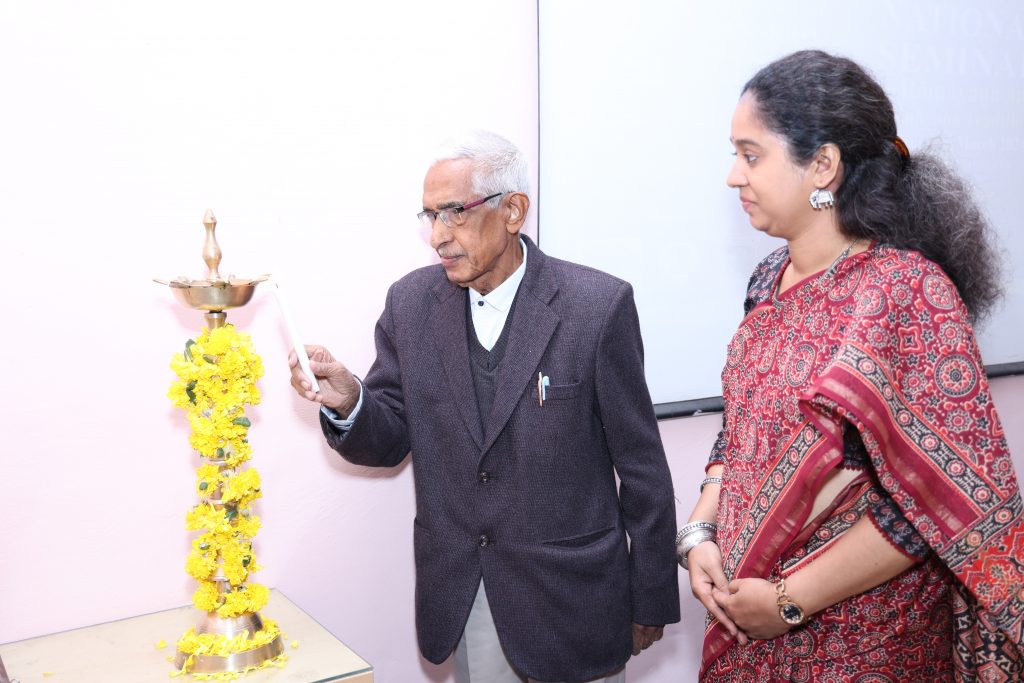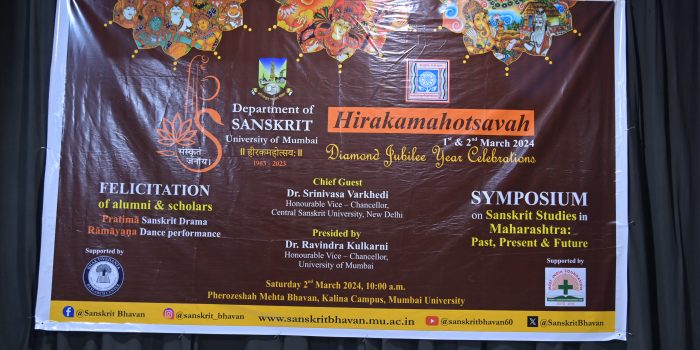UNIVERSITY MUMBAI
DEPARTMENT OF SANSKRIT
DIAMOND JUBILEE YEAR CELEBRATIONS
DAY 1: 1st march, 2024.
National seminar on Ramayana and Ramayana tradiions
The academic year 2023-24 was celebrated by the Department of Sanskrit as its “Diamond Jubilee Year”. Throughout the year, the department arranged and propagated a series of 60 lectures on a variety of subjects. As a part of the Hirakamahotsava, the seminar on Ramayana and Ramayana traditions was organised on 1st March, 2024, at the Ramakrishna Bajaj Bhavan, in the University Campus at Kalina Mumbai. The whole day program was divided into three parts; the Inaugural session with key-note address and two sessions of paper presentations by eminent scholars from various parts of India.
In the inaugural session, the head of Sanskrit Department, Dr Shakuntala Gawde, welcomed all the dignitaries, guests and students. She gave a brief report about the Diamond Jubilee year celebrations. She proceeded to give the conceptual background of today’s session, which she said has been organised in collaboration with the Bhaktivedanta Foundation.
Dr Madhavi Narasaly then introduced the keynote speaker, Dr Vijay Pandya, former Professor of School of Languages, Gujarat University. She welcomed him as the oldest student of the department. Amongst his innumerable achievements, she mentioned that in his studentship, he won the Bhandarkar price and the Dakshina Fellowshp. He has written over 65 books. He has been honoured by the Presidnt of India’s Certificate and awards from Gujarat State Sahitya Academy awards. Most importantly, he has translated the Critical Edition of Ramayana in to Gujarati, the only translation in to any regional language, done so far.
Dr Pandya began with his reminisces about his alma mater, the Sanskrit Department of University of Mumbai by saying this is his ‘Gurubhoomi’ and ‘Matrubhoomi”, where he studied from 1960 -1966. The topic of his address was “With Valmiki Ramayana as the Ultimate precedent, the multiplicity of Ramayanas and Ramayana traditions is an adornment and not a blemish”. He started off by saying that the Valmiki Ramayan does not depict Shri Rama as a divinity but as a human being. Rama comes out as a human and humane personality in the Valmiki Ramayana. Aaccording to Valmiki, Rama is the personification of ‘Truth’. He then talked about the numerous adaptations of Valmiki’s Ramayana which prove the everlasting popularity of Ramayana across regions, countries, languages and religions. He however was critical of some adaptations which in the guise of creativity have been irreverent. Talking about the Ramayana traditions he shared the anecdote of how people from Janakpur in Nepal consider Rama as their son in law and so do not even drink water in Ayodhya as it is the place of their daughter’s home after marriage. He concluded by emphatically saying that some academicians indulge in attempts at belittling Valmiki Ramayana by calling it a ‘Telling” rather than a text. But telling or ‘Shruti’ has been an ancient tradition of India, and no one should doubt the primacy of Valmiki Ramayana. Dr Pandya, although an octogenarian, spoke with tremendous strength and enthusiasm for over an hour without a break and held the audience of not only students but also of other eminent scholars spellbound in his hour-long keynote address.
The first session of paper presentation started post lunch under the chairmanship of Dr. Pandya. Three scholars of eminence presented their papers in this session.
Prof. Dr Siddharth Wakankar, former deputy Director of Oriental Research Institute, Baroda, who is credited with managing the task of bringing out the ‘Critical Edition of Ramayana’ was the first speaker. He spoke about his experiences. He explained the enormity of the task and also about its objectives.
He was followed by Dr Gauri Mahulikar, former HOD of Sanskrit Department of UOM and presently, Academic Director CIF, Veliyanand, Kerala. She spoke about how Ramayana got propagated to all corners of Asia. There were three prominent carriers viz, Siblings of the crown princes, traders and pilgrims. She then narrated about Ramayana’s references in the landscapes and temples in Sri Lanaka which fascinated her. She concluded by quoting from a few Marathi folk poems to support her arguments that people everywhere have considered Rama Sita, Hanuman etc as part of their own lives and created new and novel stories about them which are rooted in their environments and aspirations.
She was followed by Dr Urmi Shah, Associate Professor, St Xaviers College, Ahemadabad. She presented her paper on “ Retelling of Conjugal love between Rama and Sita in Gujaratit Folk paramampra – A few Glimpses”. She corroborated Dr Mahulikar’s thoughts with many examples from the Folk songs from Gujarat.
In the next session, which was chaired by Dr Siddharth Wakankar, again four scholars presented their papers.
The first paper was presented by Dr Parineeta Deshpande, visiting faculty, Department of Sanskrit, university of Mumbai. Her topic was “Ramayana episode in south east Asia – some glimpses”. Her critical observation was that in south east Asia people have made fantastic changes, so much so that many times it loses any resemblance to the original Valmiki Ramayana. In some Sita is described as Rama’s sister Shanta, or as Ravana’s daughter from Mandodari.
The next paper titled “Paumacariyam – story of Ramayana in Jaina literature’ was presented by Ms Shilpa Chheda, Curator, St Xaviers College, Mumbai. She analysed the Jaina version of Ramayans by Vimalasuri and showed with Vigor how it was written in order to promote the Jaina religion. Since the Jainas lay heavy stress on “Ahimsa”, the cruel, wicked characters such as Kaikayi and Ravana are portrayed as good persons and ultimately everyone including Ravana achieves Moksha since Moksha is the ultimate objective of Jaina religion.
She was followed by Dr Yojana Bhagat, Coordinator and Assistant professor, Department of Pali, University of Mumbai, whose paper was titled “Laotian Rama Jataka – Retelling of the Epic”. She mentioned that it is written in Buddhist framework. She explored following key questions in her paper, viz. why Jataka format is used in the retelling, Why Sita is depicted as Rama’s sister, what are the other references to Rama’s sister. As in every Jataka, the main protagonist is Bodhisatva, So Rama is shown as Bodhisatva.
The final paper was from Dr Uma Vaidya, former vice-chancellor of Kavikulguru Kalidasa University, Nagpur. Her topic was “Yogvashishtha, within and beyond the orbit of Valmiki Ramayana’. Since she could not come personally, it was read out by her colleague Dr Londhe.
The whole days program was a resounding success. Everyone heartily agreed with Dr Vijay Ppandya’s observation that the topic of the seminar is very vast and to do full justice to it, the department should organise a series of such seminars.
Symposium
On
Sanskrit Studies in Maharashtra – Past, Present, and Future.
The second day’s program was divided into three parts; viz. two sessions of Symposium on “Sanskrit Studies in Maharashtra – Past, Present, and Future”, Address by the chief Guest, Book Releases and Felicitation of scholars and final session of Cultural events by eminent artists. The day’s proceedings were started by Dr Shakuntala Gawde by elaborating on the topic of the symposium. The topic was finalised in collaboration with Central Sanskrit University, Delhi. What was the golden age of Snskrit education? what has happened in the past? what can be the roadmap for the future? She said that these and similar questions are expected to be discussed in the symposium.
The first session of symposium was chaired by Dr Kala Acharya, Emeritus Professor of Dharma studies at K J Somayya College Mumbai. In this, three papers were presented.
First paper was presented by Dr Manjusha Gokhale, Dean Tilak Maharashtra Vidyapeeth, Pune. She spoke about Mahamahopadhyaya V. V. Mirashi as a person and his work. She told that Shri Mirashi was perhaps the first one in India who studied Prakrit literature, Archaeology, Epigraphy and Numismatics besides Sanskrit literature. As a result, his treatises on the ‘Kalchuri’, Satvahana’, ‘Vakataka’ and ‘Shilahara’ dynasties hold immense value even today. Through similar integrated study, he proved beyond doubt that the ‘Ramgiri’ described by Kalidasa in Meghdootam, is indeed the ‘Ramtek’ situated near Nagpur. His other favourite author was Bhavabhuti. So, he walked on foot following cues from his works and established Bhavabhuti’s location. Shri Mirashi always made special efforts to write all his works in English and Marathi. His book titled ‘Location of Ravana’s Lanka’ is also well researched.
The second speaker was Dr Parineeta Deshpande, visiting faculty, Department of Sanskrit, university of Mumbai. Her topic was “Contribution of Maharashtra to the fields of Dharmashastra and Arthashastra”. She started by recounting the names of scholars starting from Vijnaneshwara in 12th century who wrote ‘Mitakshara – a commentary on Yajnavalkya Smriti’ followed by Hemadri, Sabaji, Pratapraj of 16th century, who wrote about ‘Dattak Vidhana’. She then informed about the illustrious Bhatt family of Paithan. Narayan Bhatt who wrote the books like ‘Prayog Ratna’, ‘Vivad Ratna’, ‘Tristhali Setu’. Neelkanth Bhatt, who wrote “Vyavahara Mayukha’ the work of paramount authority on Hindu law. Gagabhatt who coronated Chatrapati Shivaji Maharaj and also wrote the justificatory treatise ‘Shivarajyabhishek Prayog”. Anantdev who wrote ‘Dharmakalplata’ and ‘Kayastha Nirnaya’. And finally Nagoji Bhatt known for his contribution to grammar, wrote on ‘Daily conduct, and Expiation’. She explained how Shri Balkrishna Payagunde from Nagpur wrotea commentary on ‘Mitakshara’ and established that in Hindu law, the meaning of the word ‘Bhraatara’ also includes sisters. He thus established the right of direct sisters in the share of ancestral property. Pradna Pathashala of Vai, started preparation of ‘Dharmakosha’ in 1937 and has so far produced 25 volumes. Equal amount of work remains pending according to them. Raosaheb Mandlik is credited with the production of critical editions of ‘Dharmashastra’ ‘Manusmriti’ and ‘Yajnavalkya smriti’. Finlly Bharat Ratna Mahamahopadhyaya Shri P V Kane’s 5 volumes of Dharmashastra running in to 6500 pages is considered the last word on Hindu Dharmashastra. She lamented the fact that since the ceremonial burning of Manusmriti in 1927, its study has been neglected, although more than 20 Manuscripts are available in various places in India. Regarding Arthashstra, she talked about Balwant Ramchandra Hivaragaokar who wrote the Marathi translation of Kautilya’s book in 1927, based on Shamashatri’s book. It has the introduction written by Smt Durga Bhagwat and was published by Varada Books. Prof. Kangle’s translations of Arthashastra in English and Marathi have become standard textbooks for the students of Arthashastra everywhere.
The third paper was presented by Dr Vaishali Dabke, Head of Dept and Assistant professor, Ruia College Mumbai, and she spoke about “Contribution of Dr G.K Bhat in to Sanskrit Literarture”. Dr Bhat was the first person who started the genre of higher criticism, especially using aesthetics and poetics. She mentioned three examples amongst many of his works as more well known, viz. his aesthetic criticisms of Sanskrit dramas, translations of Sanskrit dramas into English and Marathi, and ‘Madhudhara’ a collection of articles from Sanskrit periodicals.
The chairperson Dr Kala Acharya applauded all scholars for their presentations. She also shared a few personal memories about Dr Bhat.
The second session of the symposium was chaired by Dr Girish Jani, Director, Mungelal Goenka Institute of PG studies and Research, Bharatiya Vidya Bhavan, Mumbai.
The first paper was presented by Dr Shrikant Bahulkar, Adjunct Professor Department of Pali, Savitiribai Phule Vidyapeeth, Pune. His topic was “Sanskrit education in Pre-independence days – a unique experiment in Maharashtra”. He started off by telling about the education in India before the British era. It was of three types, Shastras, Vaidiki and Yajaniki. The last was about rituals. The education was imparted over 12 years and emphasis was on meorisation. Lord Dulhousie in 1857 esablished three universities in India as suggested by member of British Parliament Charles wood, which made a sea change in the system of education. Not only new subjects were introduced but the medium of instruction was changed to English. Till then the medium of instruction was Sanskrit. According to the survey of N. C. Kelkar, the withdrawal of governmental support, led to closure of 500 Sanskrit paathashalas in just 10 years between 1900 to 1910. The pace of closure just accelerated after that. The British started for the first time teaching of Sanskrit through English. Still Sanskrit was a compulsory subject in schools till independence. Post Independence it was made optional. During this period in 19th and 20th century, Lokmanya Tilak through his mantra of ‘Chatuhsutri”, encouraged changing the medium of education to the mother tongue. He called it the “Rashtriya Shikshan” or “Nationalistic Education”. First such school that was started was Tilak Maharashtra Vidyalaya TMV. This was promptly banned by the British Government. Still, due to tireless and selfless efforts of many scholars, TMV continued to function and flourish. They started BA level course called Visharad and MA level course called Parangata. These degrees were not recognised by the British Government. For many years even after independence, TMV continued to function as only a certificatory body, conducting various levels of examinations in Sanskrit. This was a shining example of Maharashtra’s contribution to Sanskrit education.
The second speaker was Dr Prasad Joshi, Pro Vice Chancellor, Deccan College, Pune, and also General Editor (I/C), Sanskrit Dictionary Project. He spoke about their dictionary project and their contribution to the teaching of Lexicology and lexicography in Sanskrit education. He surveyed the works done in this field from ancient times till date. He mentioned that Amarkosha, which is considered as the oldest kosha (except Nirukta) mentions atleast 5 previous lexicographers. But none of their works have survived. However, Maharashtra does not seem to have made any contribution to the Koshas in ancient period. Maheshwara from Maharashtra has written a commentary on Amarakosa in12th century CE. But the real contributions from Maharashtra can be said to have begun with the creation of ‘Sanskrit-Prakrit-Shabda kosha” by Anantshastri Talekar in 1853. It includes 5000 words from Amarakosha and gives their Marathi meanings. ‘Shabda Ratnakara’ published in 1870 is the dictionary of medicinal terms. In 1872 Nari Appaji Godbole and Jivaji Kelkar produced “Sanskrit-Prakrit-Kosha”. The most seminal work was done by V. S. Apte, who deserves to be called the first Lexicographer of Indian origin. He died at a very young age of 34. But in that brief period he produced 3 dictionaries. “The Students English-Sanskrit Dictionary”, “The Students-Sanskrit-English-Dictionary” and “The Practical Sanskrit-English-Dictionary”. Thereafter phenomenal work has been done by scholars from Maharashtra such as “Geervana Kosha” by Nana Oak in 1915, “Ayurvediya Shabdakosha” by Maharashtra Rajya Sahitya Sanskriti Mandal in 1963, “Bharatvarsha’s Prachina Charitrakosha and Sthalakosha” by Siddheshwar Shastri Chitrao, and the Marathi Vishwa kosha by Ketkar etc. He then described the gigantic task being undertaken by the Deccan College Pune, It started the project of compiling a dictionary based on historical principles. The project was started in 1948 under the leadership of Prof. S. M. Katre. So far, they have collected more than 200,000 words and more than 1 crore references. It encompasses 62 branches. He lamented the fact that a training in Lexicography or Lexicology does not provide good career opportunities and hence Sanskrit language students are not attracted to it.
The third speaker was Dr Leena Hunnargikar and she presented the paper on “ Contribution of Shri Krushnaji Prabhaka Vaze with reference to Sanskrit Studies”. First she described the background of Shri Vaze, who studied engineering and started working in the PWD department of the Government. However, under the influence of Lokmanya Tialk he left the job and devoted himself to the study of Sanskrit texts and started writing on 4 topics, viz, the Teaching of Dharma, Politics and governance, commerce and Shilpa. In Sanskrit Shilpa does not mean just the art of engraving or making statues but entire gamut of technical skills. He collected more than 4000 manuscripts, and deeply studied 50 manuscripts. He obtained a partial fragmented copy of Brugu Shilpa Samhita. But from that he reconstructed the “Shilpa Veda” in his book “ Shilpakalndhi”. He designed the graphics of “Bharatiya-Shilpashastra-Vistara-pata”. In it he has described 3 Khandas, viz, Dhatu-khanda dealing with natural resources, Sadhan-Khanda dealing with transportation and Vaastu-Khanda dealing with storage. The main objective of Shipa-shastra is to ensure utilisation of natural resource without damaging the eco-systems. She is pursuing her study in this subject for getting further insights into sustainable development which is the need of the hour today but was written about in Bhrugu-samhita more than 2500 years ago.
Dr Jani while applauding all the scholarly presentations mentioned that while describing the contribution of Maharashtra, one should also include Maharashtrian scholars who were and are residents of places outside Maharashtra.
After lunch, the proceedings were started again by Dr Shakuntala Gawde when she gave a detailed report on the activities of the Sanskrit department as well as the year long celebrations of the diamond jubilee. This was followed by book releases of 4 books written by teachers of Sanskrit department. The book release was followed by a heart warming function wherein 24 persons comprising of eminent scholars and alumni of the department were felicitated by the Chief Guest, viz. Shri Shrinivasa Varkhedi, Vice-Chancellor of Central Sanskrit University, New Delhi.
Dr Varkhedi then delivered his address as the Chief Guest. He mentioned that he has skipped another important event in New Delhi which is presided over by the President of India, and instead has come for this function. He said that we Indians are very fond of celebrations. (उत्सवप्रियः). We are celebrating the completion of 60 years of Sanskrit department. But we should stop celebrating the past. The past must be acknowledged but we should celebrate the present and plan for the future. The 60 years have led to the creation of a tradition (Parampara). As the name diamond jubilee suggests, the institution has faced the hardhips and has emerged shining like a diamond. Now we should think of value addition for the future. Earlier, Sanskrit study was equated with the study of a language, just like study of any other language. The times have changed now. Now Sanskrit is looked upon not merely as a language but as a source of knowledge and hence sought by students form all disciplines. So the future is full of many new possibilities. Secondly, it is time to remove the artificially created divisions between Sanskrit, Pali and Prakrit. This was another facet of the divide and rule policy of the British. We should now try to consolidate all three under one umbrella, one department.
In the final session, Dr Prasad Bhide and Ananya Govitrikar enacted a uniquely different performance of Bhasa’s play “Pratima”. It was an amalgamation of acting, story-telling, singing, aesthetic and poetic insights into Bhasa’s creativity and brilliance. The audience was spellbound. This was followed by the Bharatnatyam performance “Dance of Ramayana” by the disciples of Guru Srirama Narayanswami, arranged by Sriram Iyyer.
Mohan Datar (MA Sanskrit Student)

